 |
Another visit to India,
temples in Maharashtra and palaces in Rajasthan
February and March 2010
|
Our route from Mumbai to Delhi, via Maharashtra (Ajanta, Ellora), Madhya Pradesh (Mandu, Sanchi), Rajasthan (Bundi, Chittor, Udaipur, Pushkar, Amber, Jaipur) and Fatehpur Sikri and the Taj Mahal! |
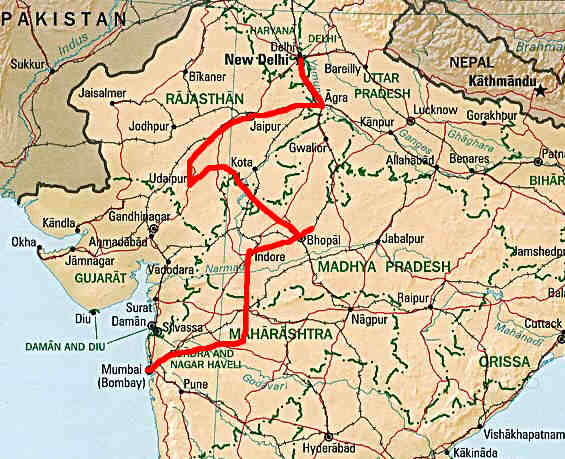
|
Maharashtra state
- Mumbai (Bombay)
|
Mon 1st to Weds 3rd Feb. We arrived at Bentley’s hotel in Mumbai/Bombay at 3am, where they gave us room 15, a very spacious, airy room with a balcony overlooking private gardens with a riot of palm trees and other vegetation. At 9am we were still dozing when they knocked on the door and delivered breakfast – clearly it was time to get up. We wandered down Colaba causeway looking at the shops then each day we went to Café Mondegar for our favourite brunch of spicy beans on toast.
We had pleasant days strolling round our ‘patch’ of Mumbai, doing some shopping, had a look at the outside of the very impressive Prince of Wales museum but didn’t go in (12 pounds charge for taking a digital camera in!) or walking down to the Gateway of India and having a look at the posh shops in the Taj hotel, then Sheila sometimes retired for a nap while I went to Indigo Delicatessen for a refreshing pot of Darjeeling tea with cumin.
One afternoon we went on the ‘Reality’ tour of Dharavi, advertised as the largest slum in Asia and famous from Slumdog Millionaire. It was a hive of industry, with people recycling rubbish, cleaning old tins, melting down plastic and dozens of other industries, all going on in murky little buildings down winding back alleys. Most people lived in or above their little workshops, or in home-made shacks for which they paid ‘rent’ to the city council. It was fascinating (although we have been to worse slums). Afterwards we got the train back to Churchgate station and went round the corner to The Tea Centre for a refreshing pot of Nilgiri Orange Pekoe tea and snacks (spicy ‘chaat’ and sizzling chocolate brownie - on a hot iron plate, and when they pour on the hot fudge sauce it spits all over the place – with extra ice cream). When I told Sheila about the sizzling brownies, suddenly a nap didn’t seem so important! One evening we walked to Churchgate, shopping as we went (Sheila bought a nice Swarovski necklace at ‘Westside’), and at the railway station we booked our ‘chair class’ seats to Aurangabad for Thursday. At one of the many road junctions packed with pedestrians trying to thread their way between the hooting traffic, a man suddenly galloped up on a horse, executed a turn across three lanes of traffic narrowly avoiding being mown down by a bus, and galloped off up a side road!
Car parking is a problem in Mumbai - you have been warned! |
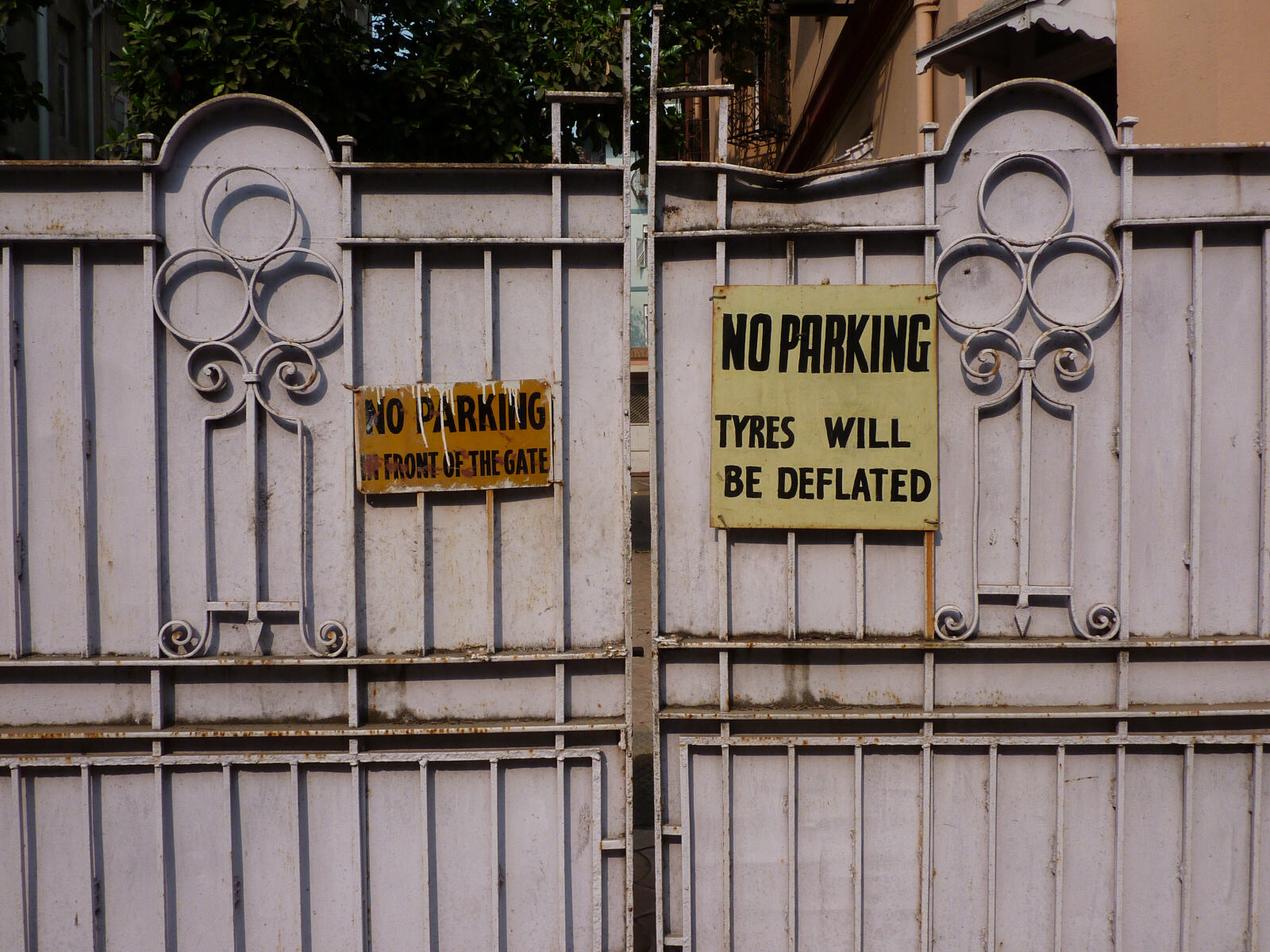
|
After a walk along the sea-front, and a couple of dare-devil road crossings at so-called ‘pedestrian crossings’, we went and had a lovely meal at the Gaylord Restaurant – I had curry of course (chicken with ginger and garlic) but Sheila had to go for the Lobster Thermidor – does she think she’s back in the Caribbean? The next evening we went back to Gaylord restaurant for a huge disappointment because they had run out of lobster. We had a nice curry and made them promise that they’d have lobster when we came back the next day, which they did, and made a great fuss of us. |
- Aurangabad, Ajanta and Ellora
|
Thurs 4th. After our usual brunch at Mondy’s we went to CST (Victoria Railway Terminal), a Unesco world-heritage listed tourist sight in its own right and the busiest train station in Asia, and found our way to the 1:50pm express to Aurangabad and got in our comfortable ‘chair class’ seats. After moving seats and re-arranging all the other passengers so that we could see out of the window we had a comfortable ride, except it was like being in a call centre – all around us mobile phones were ringing in a variety of tones throughout the journey. In Aurangabad we went to the Hotel Panchavati which was OK (not up to Bentley’s standard but a quarter of the price), arranged with a driver called Aleem to take us to Ajanta tomorrow and had a very nice meal at the Tandoori Restaurant.
Fri 5th. Aleem, the driver we expected, didn’t turn up of course (presumably had a better offer), but he eventually arranged a substitute boy racer who took us for the two-hour white-knuckle ride to Ajanta (return fare Rs 1,050 - about 75 Rupees to one pound, 65 to one Euro, 45 to one US dollar) through a series of villages, scattering the villagers and their animals in all directions. How can you describe the driving in India? It’s indescribable. Once you have driven the wrong way down a dual carriageway just to get to a particular restaurant, you think everything is normal. The technique is, whether you are a pedestrian, cyclist or driver it is important never to look left or right – simply go to where you want to be and assume nothing is coming. Animals, of course, do whatever they like and cows often feel like a nap in the middle of a busy road with huge lorries thundering towards them, but they don’t worry because somehow everything goes around them. When it comes to overtaking, might is right. It is quite normal for a lorry to overtake a bus which is overtaking a slow car on a narrow road, and if anyone is unfortunate enough to be coming the other way their only option is to go into the ditch. It helps if this all happens on a blind bend, of course. As a passenger you cannot attempt to sleep to get away from it all because your driver, indeed all the other drivers, have their hands on the horn continuously. And if you find a traffic jam, the best thing is to get in as close as you can, to block any escape route for any of the other traffic! |
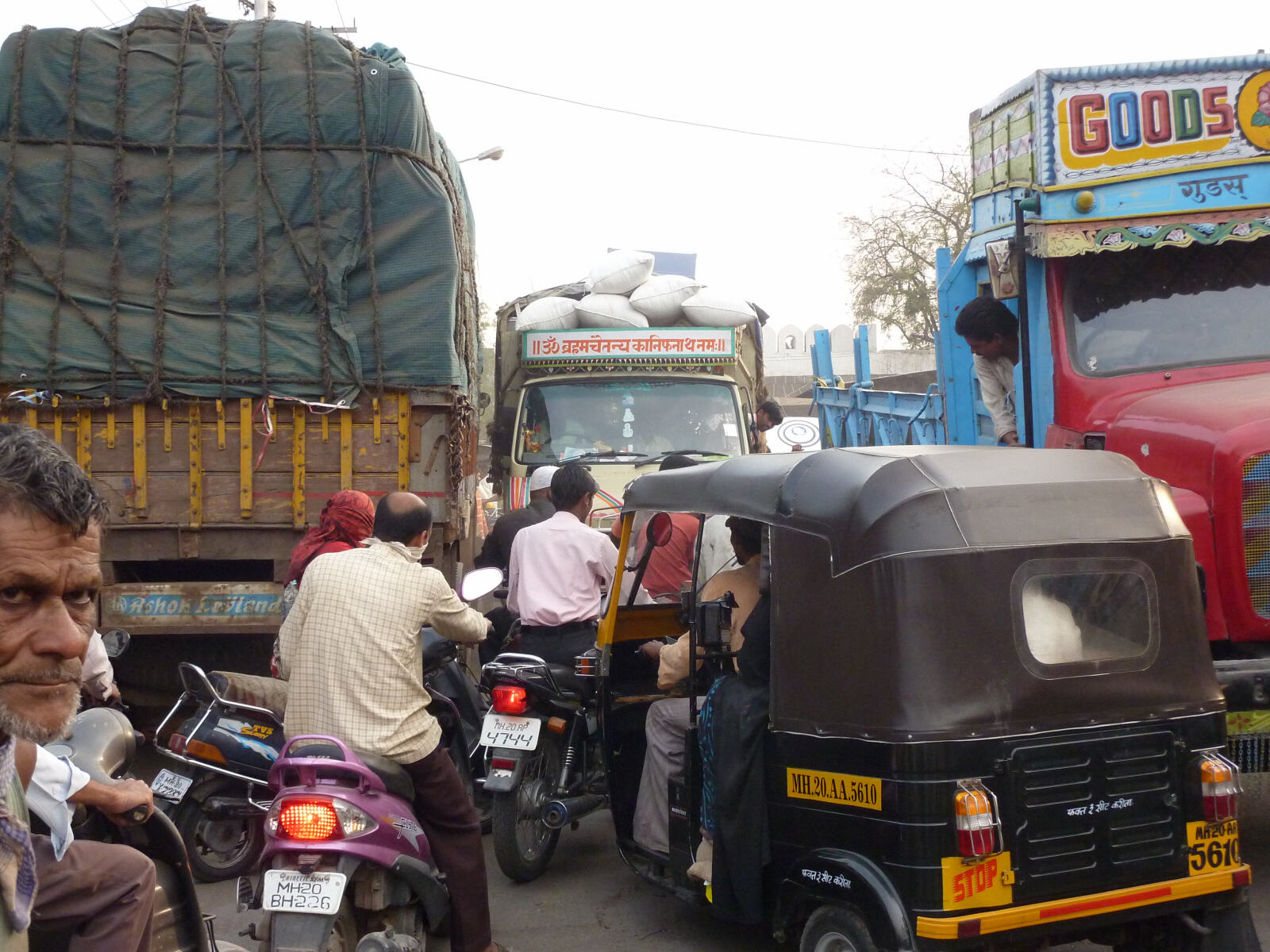
|
We passed through agricultural scenery including cotton, corn, sunflowers and grapevines, past slow creaking buffalo-carts laden with sugar cane. Ajanta is a range of rock-cut Buddhist temples dating from 100BC to 400AD, which were abandoned and forgotten about the year 480, and which remain in remarkable condition with elaborate carvings and paintings on the walls inside. It was all very impressive. |
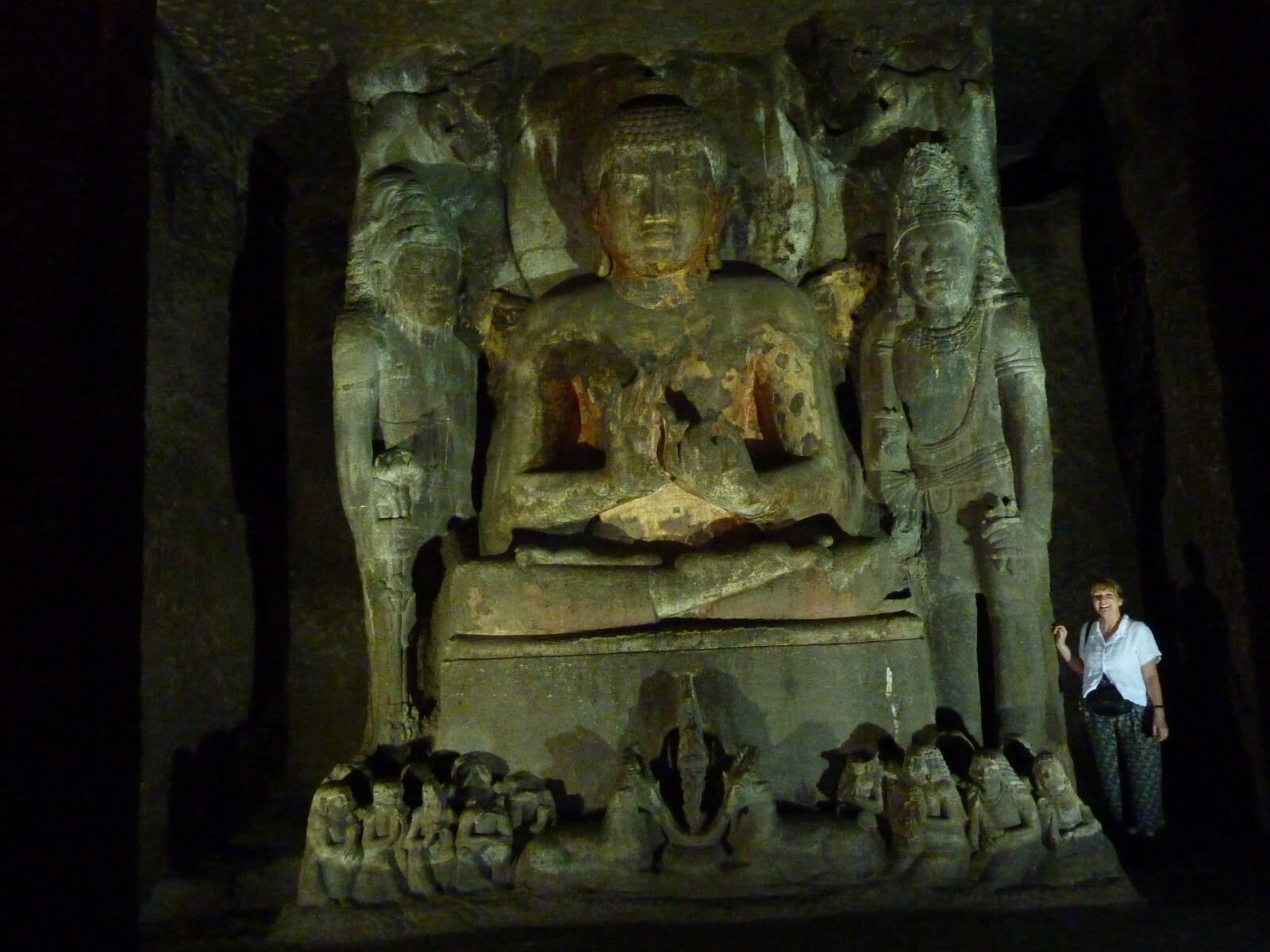
|
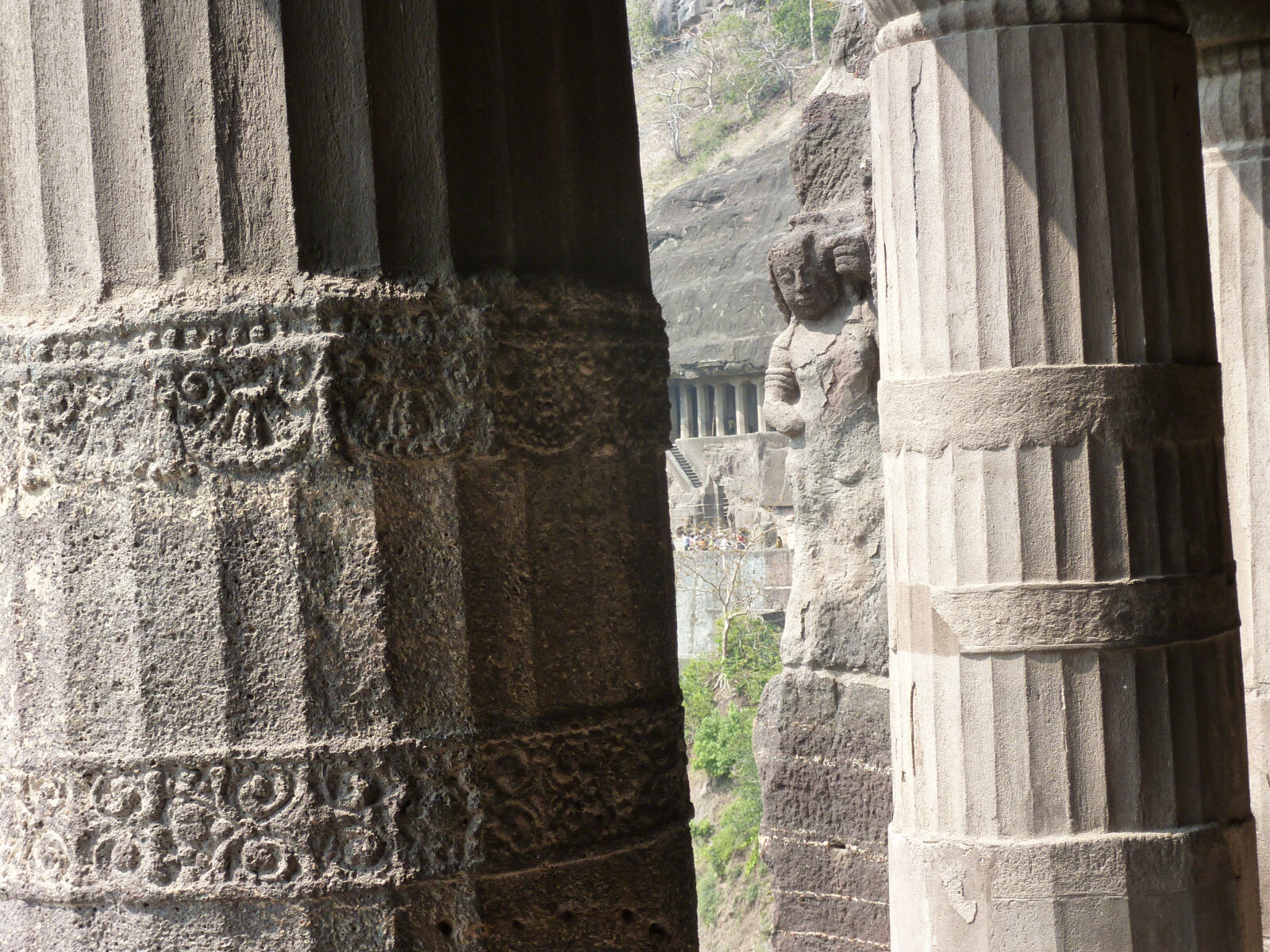
|
Sat 6th. After a late start we went on the tour to Ellora with Aleem (Rs 750) and it was also very impressive. In Ellora there were a selection of Buddhist, Hindu and Jain rock-cut temples (Ajanta was all Buddhist) one of which, the Kailasa Temple (number 16), is definitely not to be missed – a complete, complex temple with buildings, statues, pillars and stone elephants, all carved top-down out of a huge stone cliff – we climbed up to see it from the top as well. |
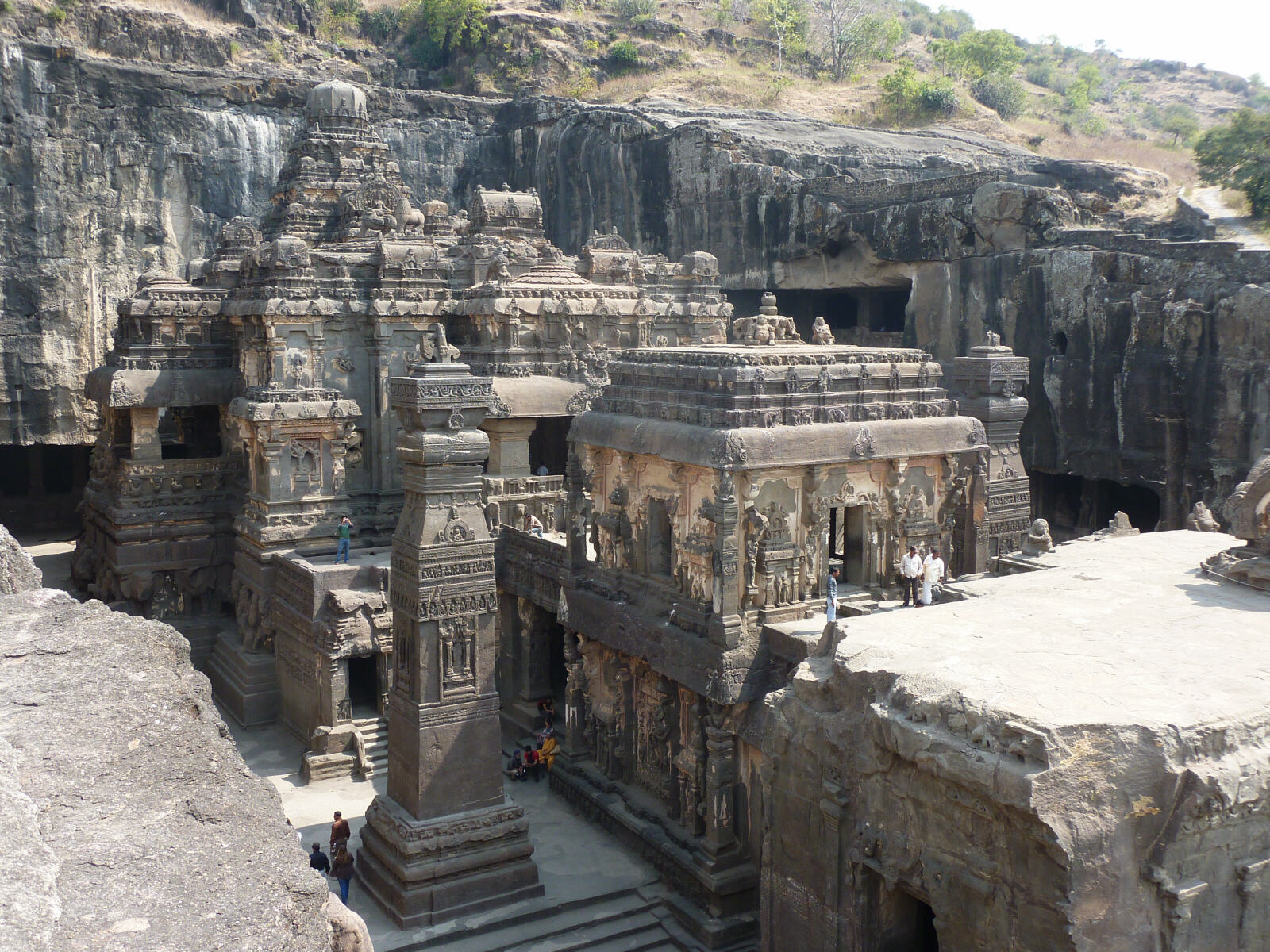
|
An unfinished carving in one of the Jain temples at Ellora - |
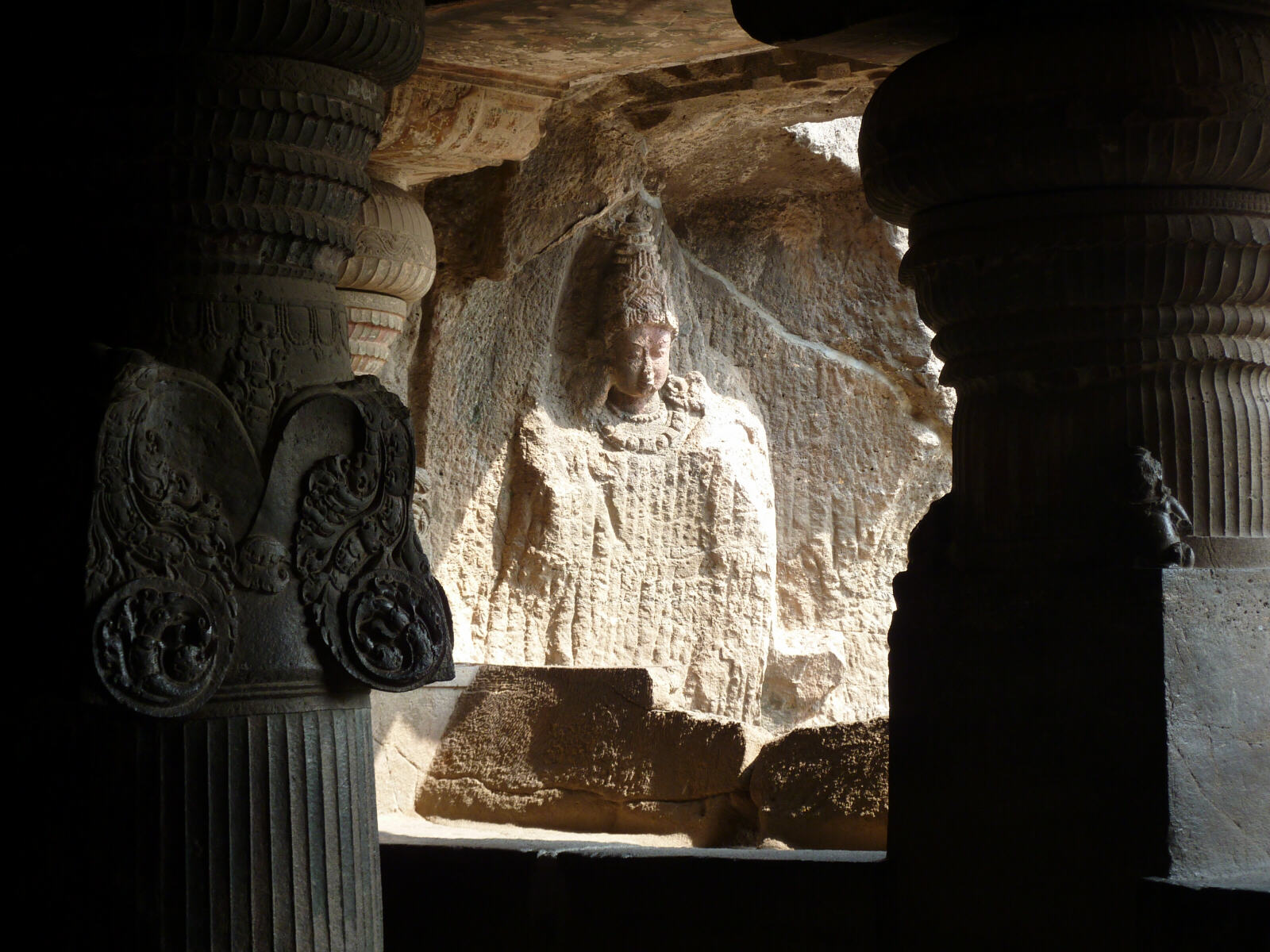
|
On the way back to Aurangabad Aleem took us to his home village, Khultabad, to visit the tomb of Aurangzeb, the last great Mughal emperor. In Aurangabad we visited the ‘poor man’s Taj’, the mausoleum for Aurangzeb’s wife (rather ironic because Aurangzeb overthrew his father on the pretext that he was being too extravagant), and drove through the old town and the markets. After freshening up at the hotel (which has a 24-hour checkout system so we don’t have to leave until 8pm) we caught the sleeper bus to Indore. It should have been fun but it turned into the ride from hell as the music blasted out, the bus rattled over the potholed road and the bus driver and his mates’ cigarette smoke filled the bus. |
Madyha Pradesh state
- Indore, Mandu, Sanchi and Bophal
|
Sun 7th. We arrived at 6am in the freezing cold and Indore was asleep. There were no taxis or buses so all we could do was get an auto-rickshaw to the President hotel where they very kindly let us sit in the lobby and use the loos until it got light (imagine trying that in England!). We tried to negotiate for a car tour to Mandu but the prices seem to be fixed and we ended up paying a steep Rs 1,500 for the car there and back. Mandu was nice with lots of 15th-century palaces, pavilions and tombs, but we were tired and disgruntled after getting no sleep and we didn’t really appreciate it. After looking at a couple of really awful hotels in Indore at 7 pounds a night, we stayed at the quite nice nearby Hotel Sunder for 10 pounds and had a very good meal (the tastiest egg curry ever, veg curry and beers) in their restaurant and an early night. Our greatest fear that the wedding celebrations taking place in the hotel would start belting out loud music all night didn’t happen and we slept well.
Mon 8th. We took the easy option and hired a car for the 300-km ride to Sanchi (then back to Bhopal) for Rs 3,800. Sanchi was lovely, a Buddhist stupa set in parkland on a hill with elaborately-carved gates and the ruins of other stupas and monasteries around it. |
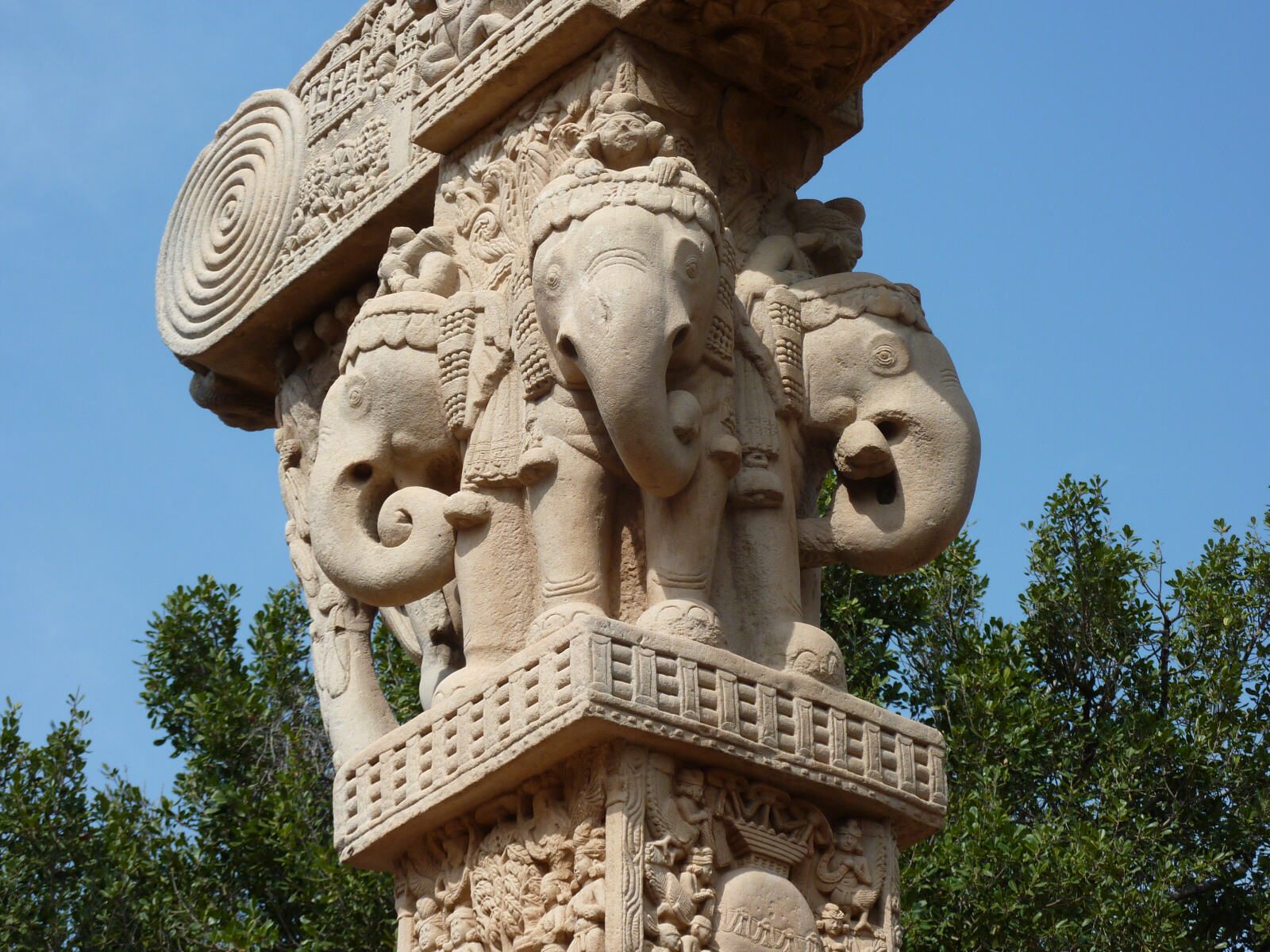
|
In Bhopal we went to the very pleasant Sonali hotel and had an executive air-conditioned room with balcony for 11 pounds (the cheaper non-AC rooms were full!) With a bit of time to spare we stopped an auto-rickshaw whose driver spoke some English, and he took us on a one-hour tour of the city for Rs 200. It was good fun, we went along the promenade by the lake and through the seething markets and past the biggest mosque in India. Foreigners seem quite unusual here so he stopped to pick up his friend who came along for the ride. In the evening we went down the alleyway to a nearby hotel whose restaurant seemed bigger and brighter than the one in our hotel. They tried to put us in the gloomy ‘family’ section upstairs, but we stayed in the downstairs section with the men knocking back the whiskey and sodas and had our usual beer and curries. Outside, numerous motorbikes were parked on the pavement and we thought we must be in the local Hell's Angels meeting place! |
Rajasthan state
- Bundi
|
Tues 9th. Breakfast at the hotel (included in the price) was an Indian buffet so I started the day with chickpea curry, rice and lime pickle while Sheila had the more conventional toast and jam. Our driver and his navigator turned up 15 minutes early and at 9am we were off on the long drive to Kota in Rajasthan, going virtually non-stop and arriving at 3:30. They took us to the bus stand and helped us find the local bus to Bundi, which even had reserved seats from the computerized reservations office, after we had jettisoned a local family from our reserved seats (and they didn’t go quietly). By 5pm we were in Bundi and stayed at the lovely Haveli Braj Bushanjee in an atmospheric 250-year old house, in a room with high ceilings, oval stained-glass windows, alcoves and a spacious, spotlessly clean bathroom, for Rs 1,500 (20 pounds) – what luxury. |
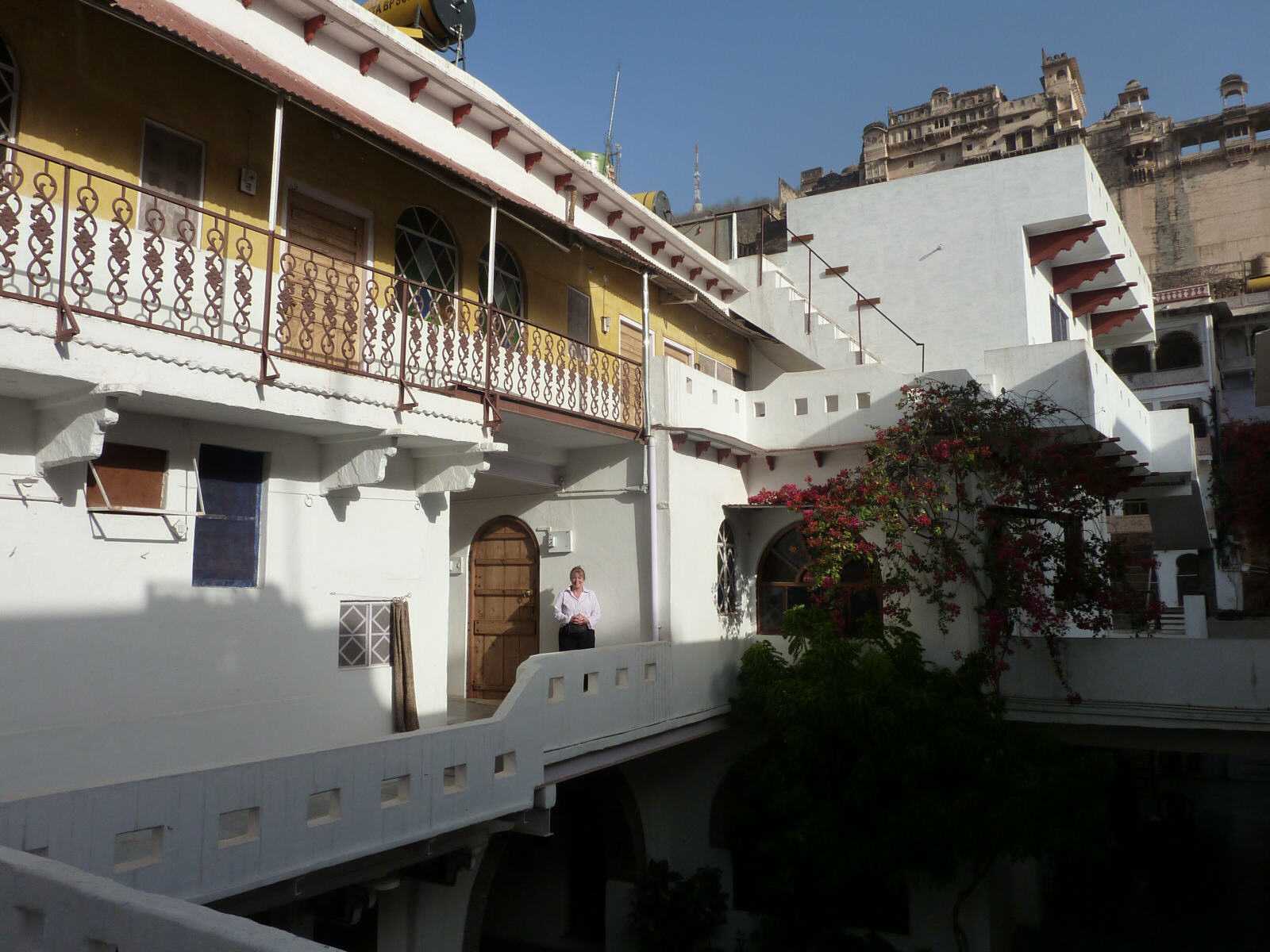
|
We had a walk down the main street, out through one of the city gates and round the colourful vegetable market. |
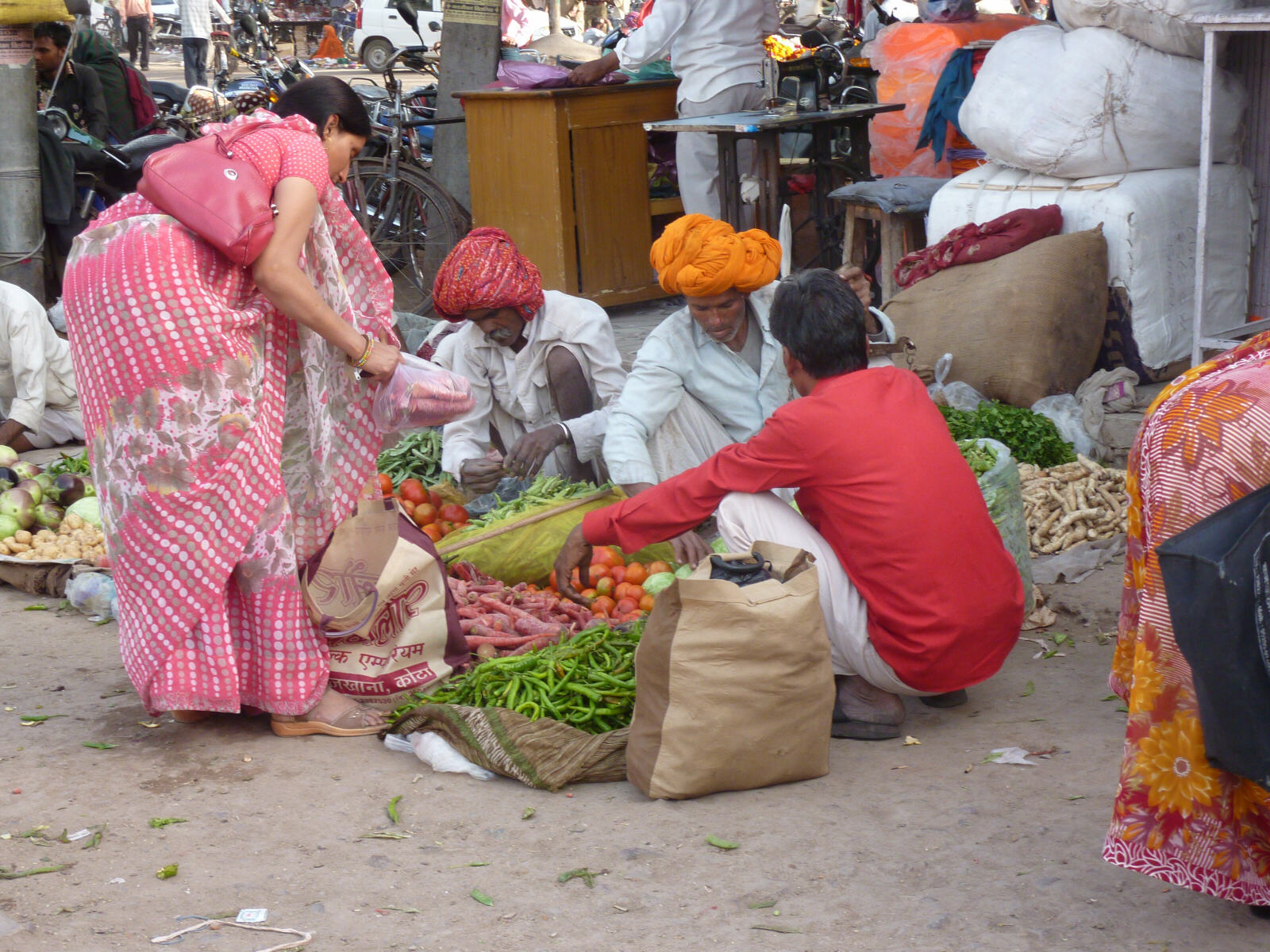
|
Then we went in search of somewhere to eat, but the options seemed rather limited. We had first course of beer, masala popadoms (with a topping of chopped onions, tomatoes, lemon juice and coriander), dal soup and rice pudding at the Rainbow café, a nice little 2nd-floor terrace overlooking the main street, then main course at the Kasera Paradise Haveli restaurant where we seemed to be the only people in the whole place and Sheila went into the kitchen to help the chef/waiter/maitre d’ to cook our curries, but the result was not the greatest meal (not Sheila’s fault, I should add).
Weds 10th. After a restful night in our quiet, dark, clean haveli room we were out (relatively) early to see Bundi castle and the palace, which were both delightfully run-down and picturesque with great views across the town and valley. |
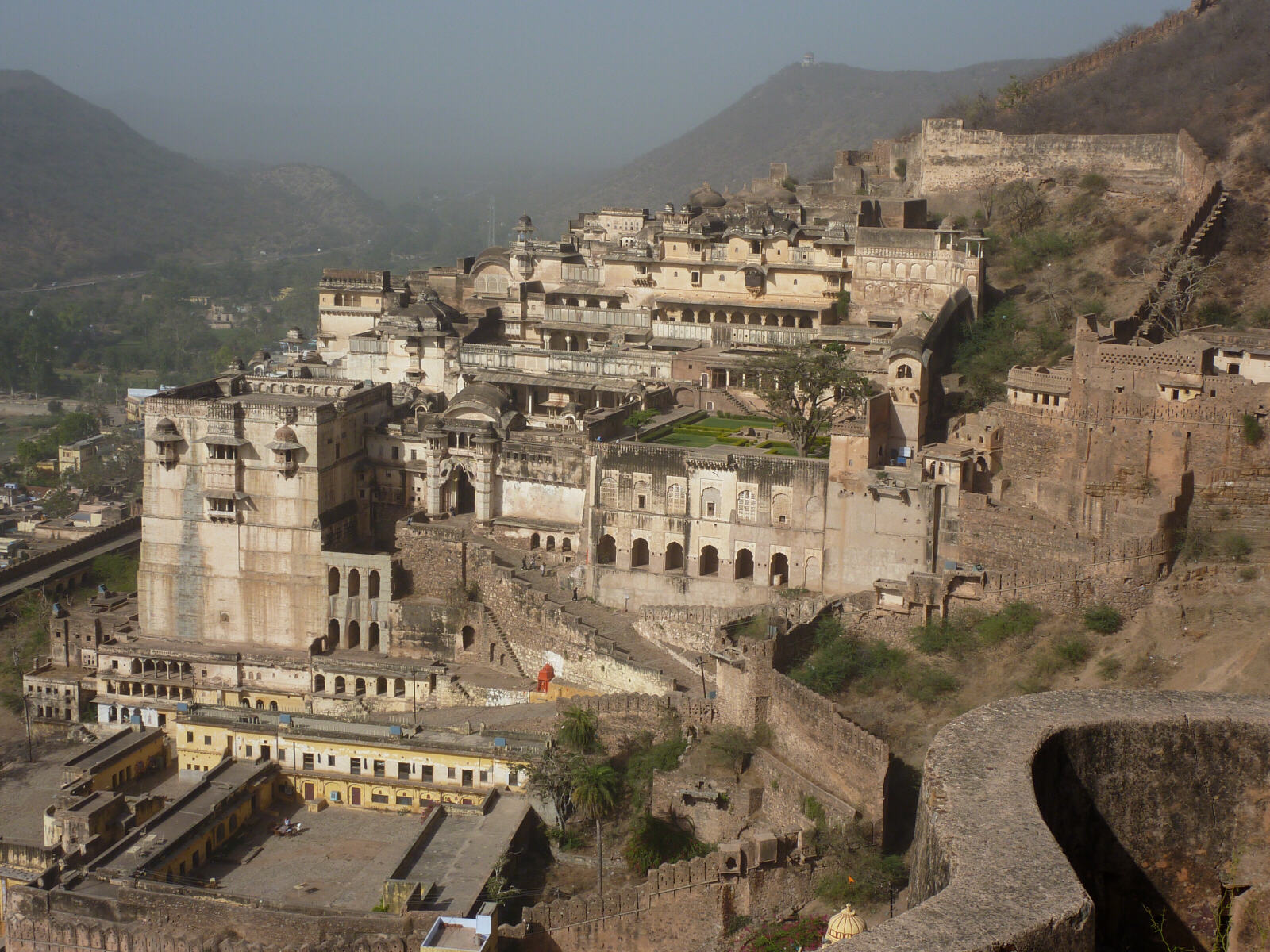
|
Apart from having to rent big bamboo sticks to keep the monkeys away (Sheila was practicing her Samurai pose as we walked along) it was a delightful spot. |
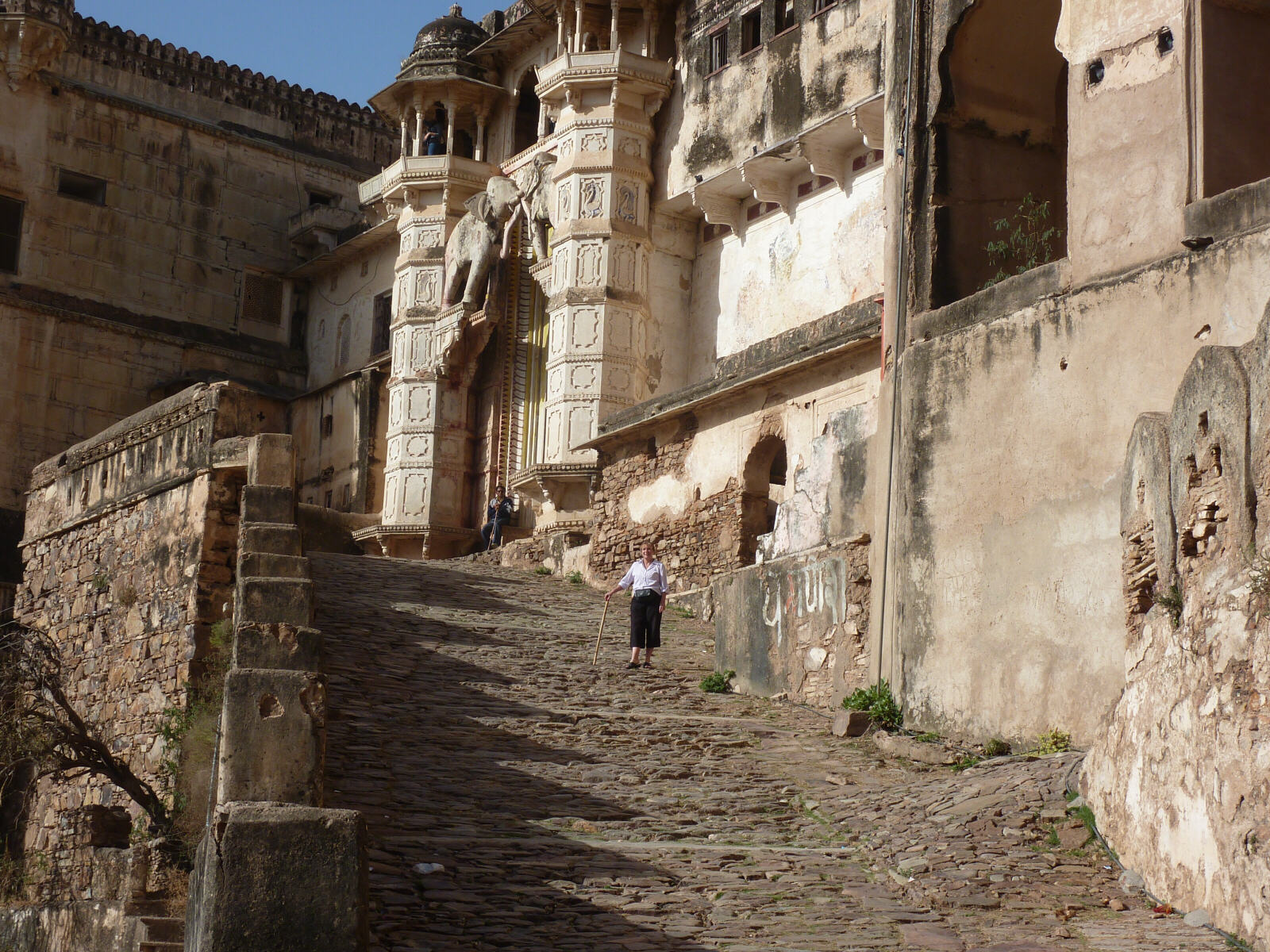
|
We went back for a nice lunch at Rainbow Café and made a fuss of their cute puppy which was clean and fluffy, unlike the mangy mutts in the street below. In the afternoon I went for a walk down to Ranij-ki-Baori, the most amazingly large and deep step-well with carvings, archways and pavilions on top of its surrounding walls; then a walk up to Sukh Mahal, a small old ‘palace’ or villa overlooking a lake, where Rudyard Kipling once stayed and wrote. We went to yet another rooftop restaurant at the Kasera Heritage View Haveli and with our first beer watched the sun set over the lake with a little temple in the middle, then turned our chairs round the other way and with our second beer watched the floodlit palace, now deserted by humans and owned by the monkeys that prowled along the ramparts and ledges, and in and out of the windows. In most towns people hang washing out on their rooftops but in Bundi they daren’t because the monkeys would have them. We then went back to Rainbow Café for our actual dinner. |
- Chittor (Chittorgarh)
|
Thurs 11th. We were on time for the 9:40 train at Bundi’s spacious, modern railway station, but the train was not. It finally departed nearly an hour late, and eventually arrived at Chittor about two hours late. A nice young auto-rickshaw driver took us on the tour of the huge fort at Chittor, which occupies the whole of a big hill 3km long and includes crumbling palaces, active temples, a tower with eight levels that you climb up on tight, steep steps, and Padmini’s Pavilion, set in lovely gardens overlooking a lake. It was all very impressive and good value for the 100 Rs entrance fee. |
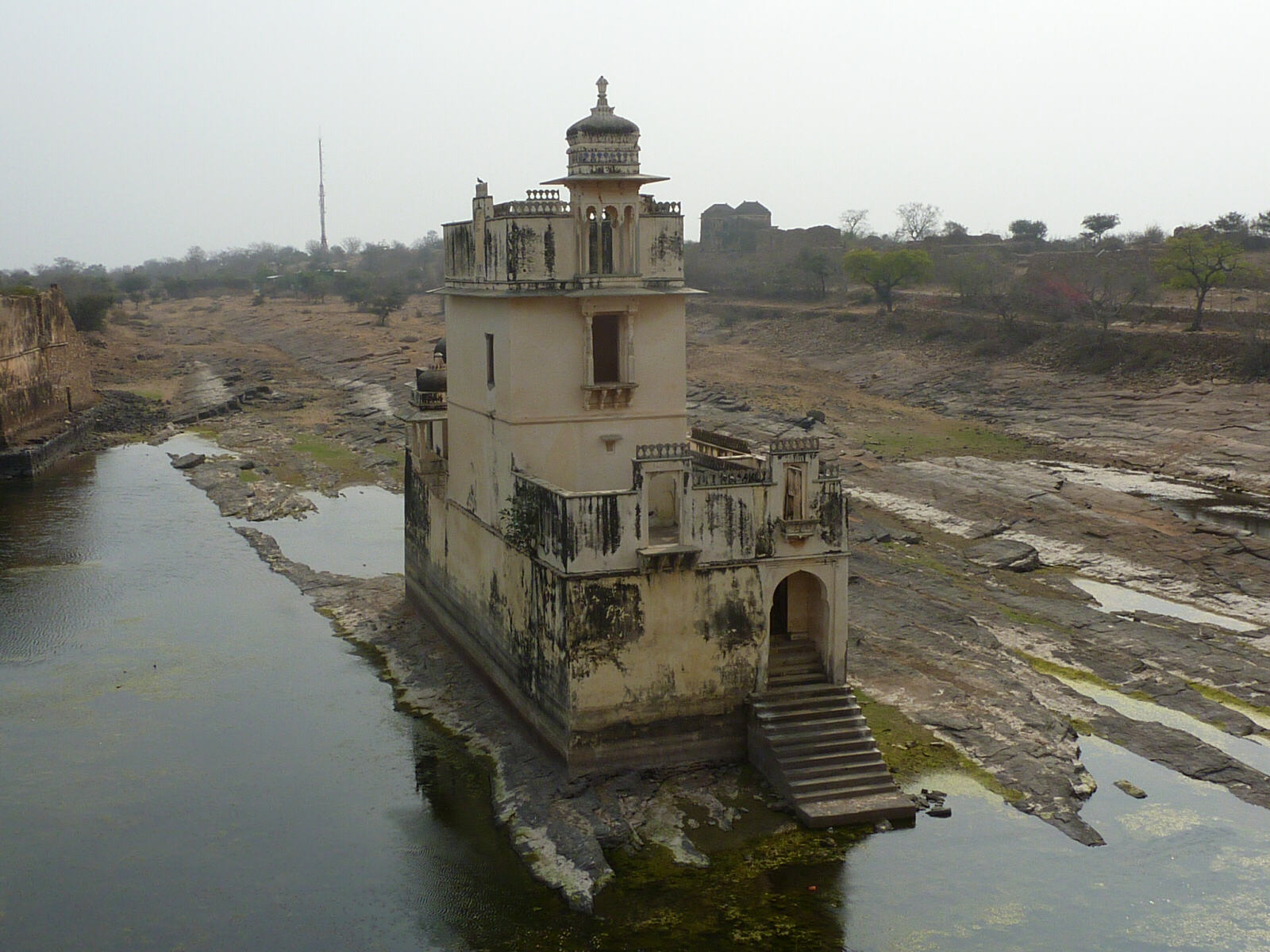
|
In the spirit of co-operation, the monkeys at Chittor help to pick the nits out of the pigs' hair. |
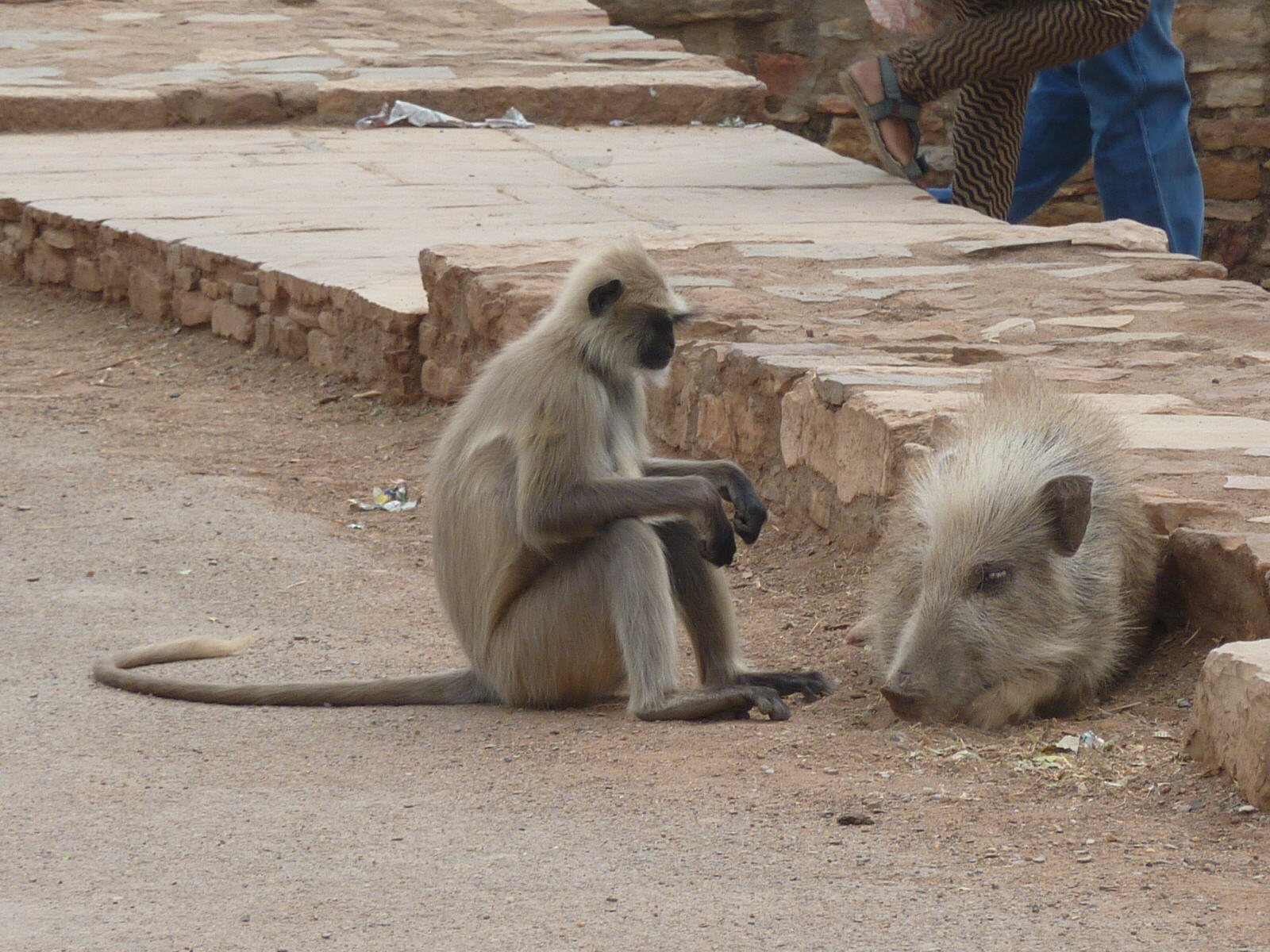
|
On the way down from the fort we stopped to stroke the magnificent Marwi horses (with the funny inwards-pointing ears) in a stable where they go after they’ve finished giving tourist rides. |
- Udaipur
|
We had planned to continue to Udaipur by train but after the previous delays we switched to the afternoon bus instead, which was crowded but we had allocated seats so it was OK. After Bundi, which was small and relatively empty of tourists we were shocked at how big and busy Udaipur was. And in particular how full up all the nice hotels were, often booked up days ahead – they all have proper booking systems (in delightfully antiquated old ledger books) rather than the haphazard ‘if somebody checks out in the morning there’ll be a room available’ approach run by hotels elsewhere. Unfortunately we can never book ahead because we can never predict where we are going to be. We found a nicely-decorated small room (with lake view) at Krishna Niwas, an old ‘haveli’ in the heart of the old town, but it is reserved tomorrow and we will have to check out in the morning. We went by auto-rickshaw to various other nice hotels and found a couple of possibilities but we will have to check back in the morning (maybe the system is not so perfect after all!) On the way back the rickshaw driver suggested we look at ‘his’ hotel so we did (it has no visible name outside but we found it was called Udai Garh) and although the hotel was full we went up to the rooftop restaurant which had magical views of the floodlit palaces floating on the lake, so we stayed and had an excellent meal, warmed by the blankets they lent us and smoked by the log fire they lit beside the table. |
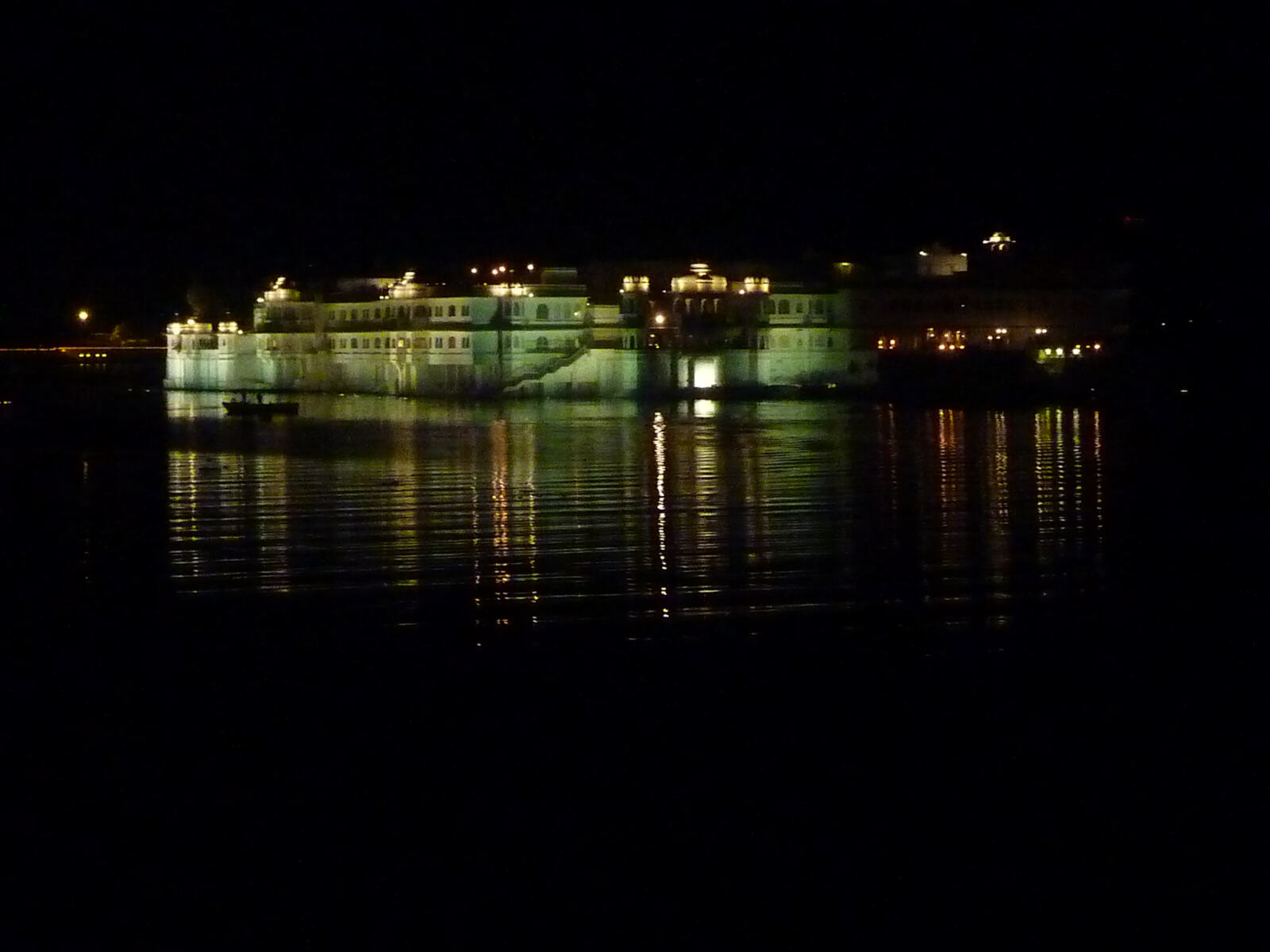
|
Fri 12th. After two weeks of being on the go most of the time we slowed down and decided to relax a while in Udaipur, so we got cleaned up and put on our best(ish) clothes and felt most refreshed. We handed in the washing again to get rid of the extra dirt that was added when we had them washed in Bundi, and this time they came back much cleaner! We moved down the road to the Kankarwa Haveli right by the lake, and had a delightful old-fashioned suite (room 204) with alcoves and wooden furniture, and a day-bed with cushions where you can sprawl and relax, enjoying the view of the lake and the pretty pavilions and palaces around it, while the washerwomen pound the clothes (hopefully not ours) on rocks below the window. |
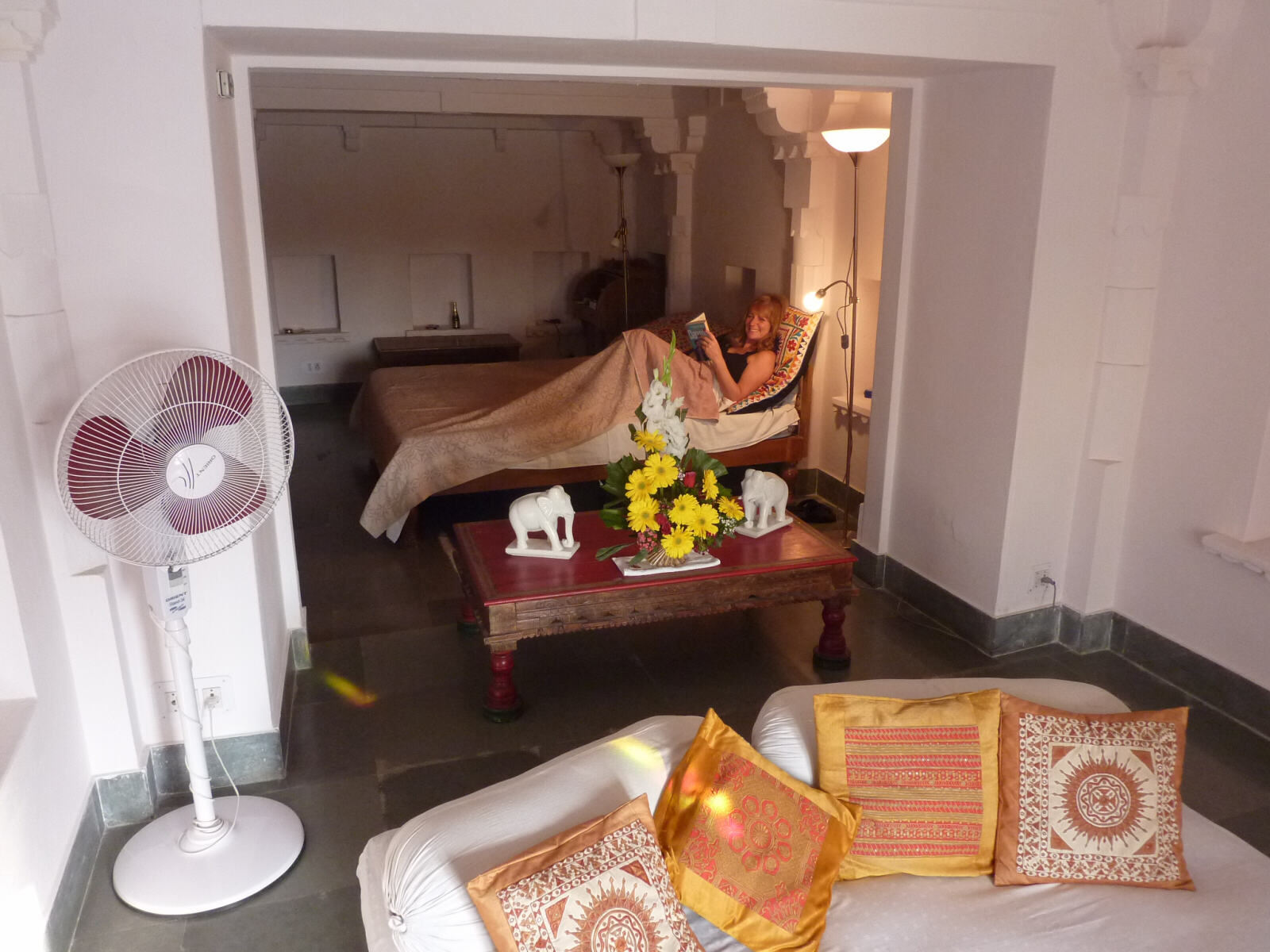
|
We walked through the old town and across the footbridge to Hanuman Ghat on the other side of the arm of the lake, and walked through rather grubby backstreets to the fortress-like gate of the hyper-luxurious Leela Palace Hotel. Today is Sheila’s 60th birthday (she told me to say that, normally I’d be too polite to mention it!) so we made reservations for lunch (dinner is reserved for residents only at the moment) and we were welcomed by uniformed and turbaned doormen, taken by electric buggy through the lovely grounds and then escorted under a beautifully decorated sun umbrella to the restaurant reception. We splashed out on sparkling wine (35 pounds) and had a lovely meal with attentive waiters anticipating our every need. A thoroughly enjoyable treat, if somewhat expensive. |
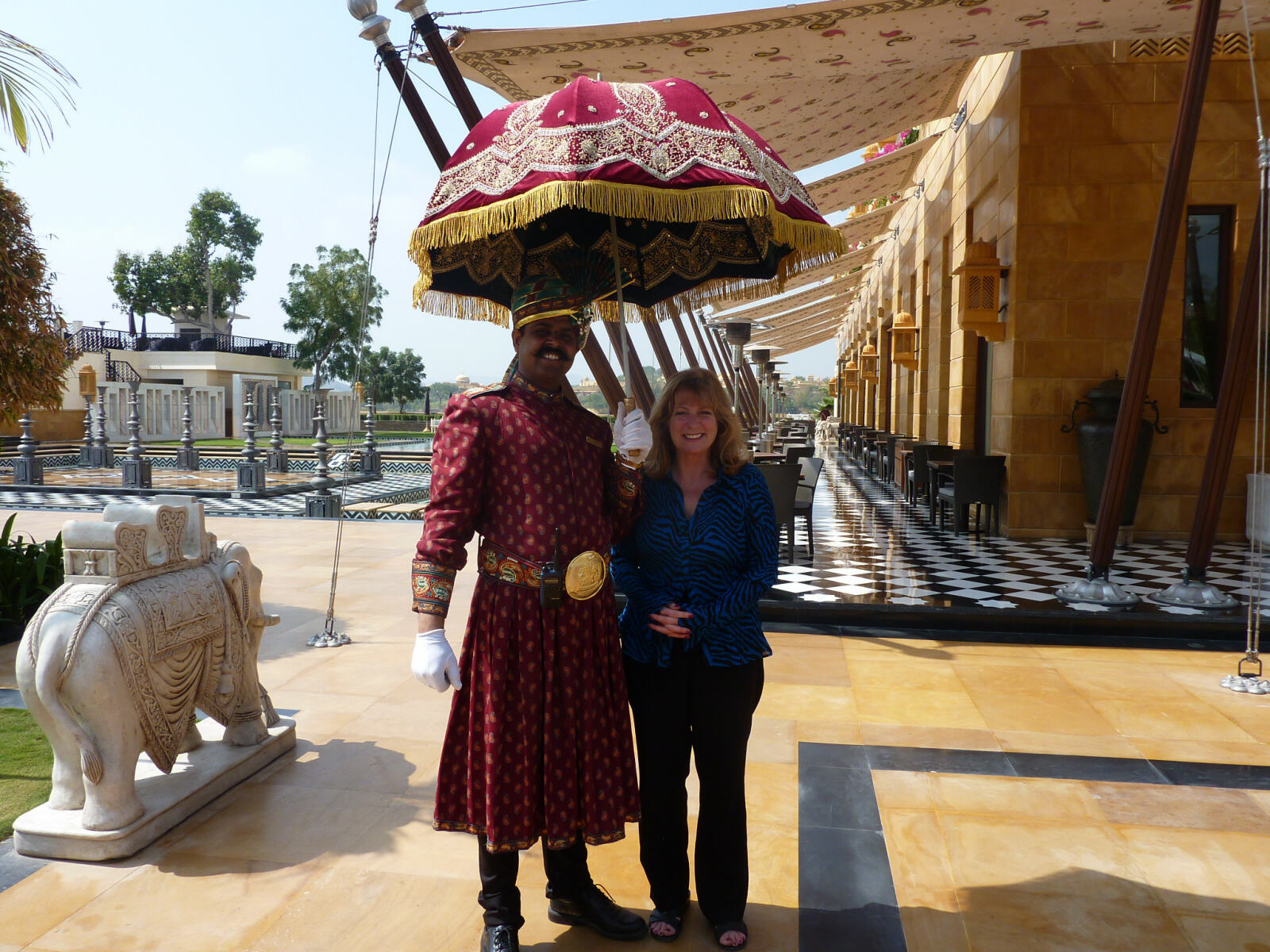
|
On the way back we went by auto-rickshaw to Chetak Circle and with some difficulty found a flower shop where we bought a flower arrangement including roses, gladioli and sweet Williams to adorn the room for her birthday. Then we had a lazy afternoon to sleep off lunch. By coincidence today is also Shiva’s birthday and all the temples in town were having festivals with decorations and amazingly loud music thumping out into the street (recorded, not performed live unfortunately). We went to ‘the highest rooftop restaurant in Udaipur’ at Lake View guest house (almost every building in the old town has a rooftop restaurant) and had a beer and a snack as we listened to the hubbub from the city below, and watched the fireworks and lights as Udaipur celebrated.
Sat 13th to Fri 19th. At leisure in Udaipur. We originally planned to stay for about three days but it’s a great place to relax and we ended up staying more than a week! After three days at the lovely Kankarwa Haveli we moved back to the less expensive Krishna Niwas hotel, just up the street. Most days we had our favourite breakfast at (another) Rainbow Café, next door to the hotel – spicy baked beans on toast and fried eggs on toast, all very tasty but prepared in a kitchen that looked like the black hole of Calcutta. We had a look round Bagore Ki-Haveli, a museum in an old palace by the lake front, Sheila had a pedicure while I had coffee and cake at the Edelweiss Café, checked the photos on a computer at an Internet café, and we spent quite a bit of time looking round the shops and other hotel/havelis.
We went to visit the very impressive City palace, which was being prepared for a mega-expensive society wedding, for the daughter of a rich marble exporter – they were erecting stages and bandstands all over the gardens, with thousands of flashing lights (not yet flashing, but they will be on the day). We went back to City Palace another day to see the Durbar Hall, the enormous meeting hall with its enormous crystal chandeliers at the heart of one of the three separate palaces, now the dining hall of one of the two luxury hotels in the complex (the other one is so exclusive you can’t go in unless you have a reservation). Around the upper gallery of the hall is the ‘crystal gallery’, full of the most amazingly opulent, rare crystal chairs, sofas, tables and even a bed, along with assortments of lights, glasses and even fly-whisk handles. It was ordered from England by the Maharaja in 1877 but he died before it arrived and it all just sat in its packing cases for over 100 years before it was unpacked and put on view in the gallery. We had the ‘free refreshment’ included in the tour on the hotel’s sunset terrace (half a cup of tea) then walked around the outside of the even more exclusive Shiv Nivas Palace Hotel, which was as close as we were allowed to get.
Udaipur City palace - the gateway .... |
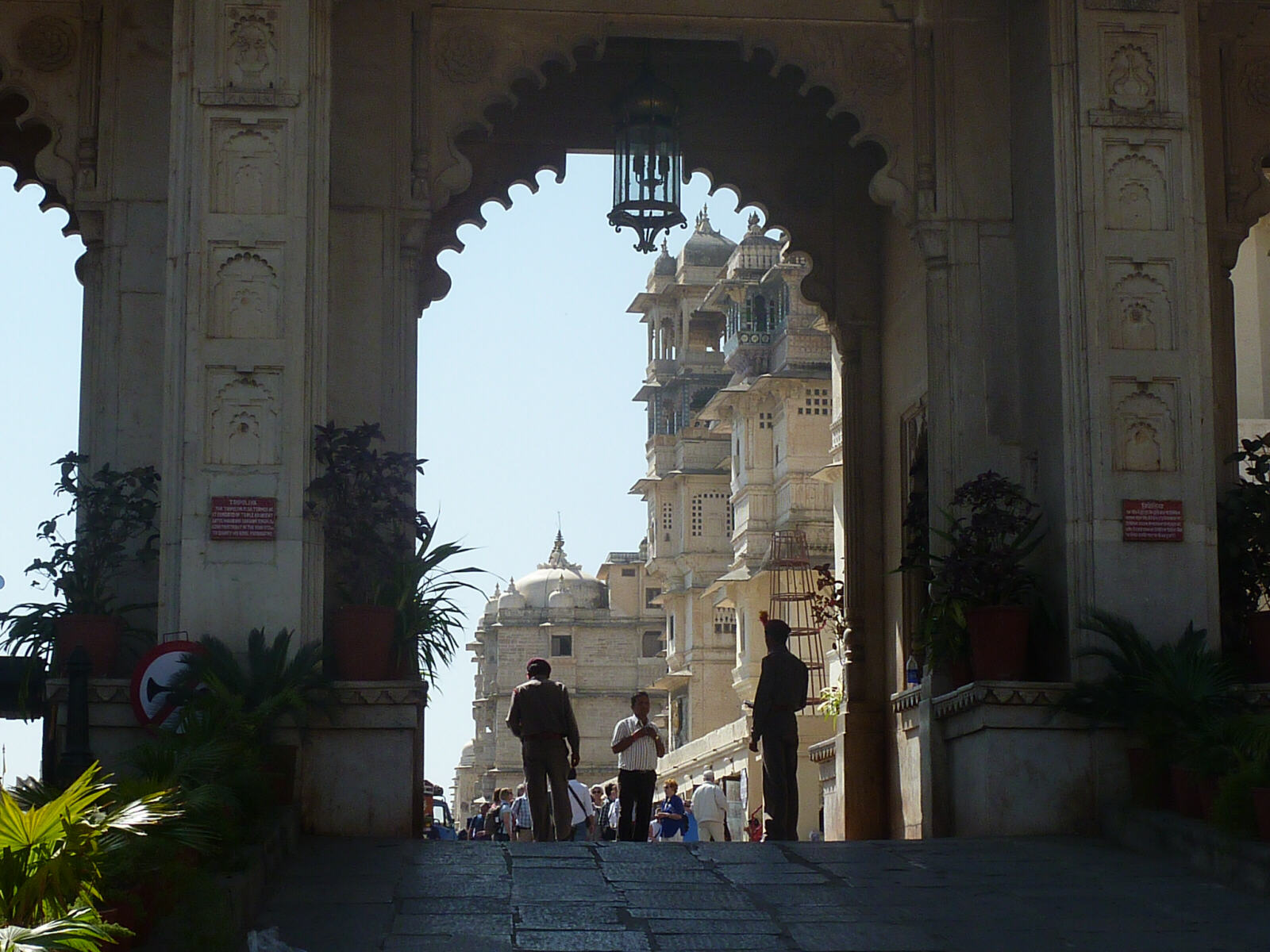
|
.... the door .... |
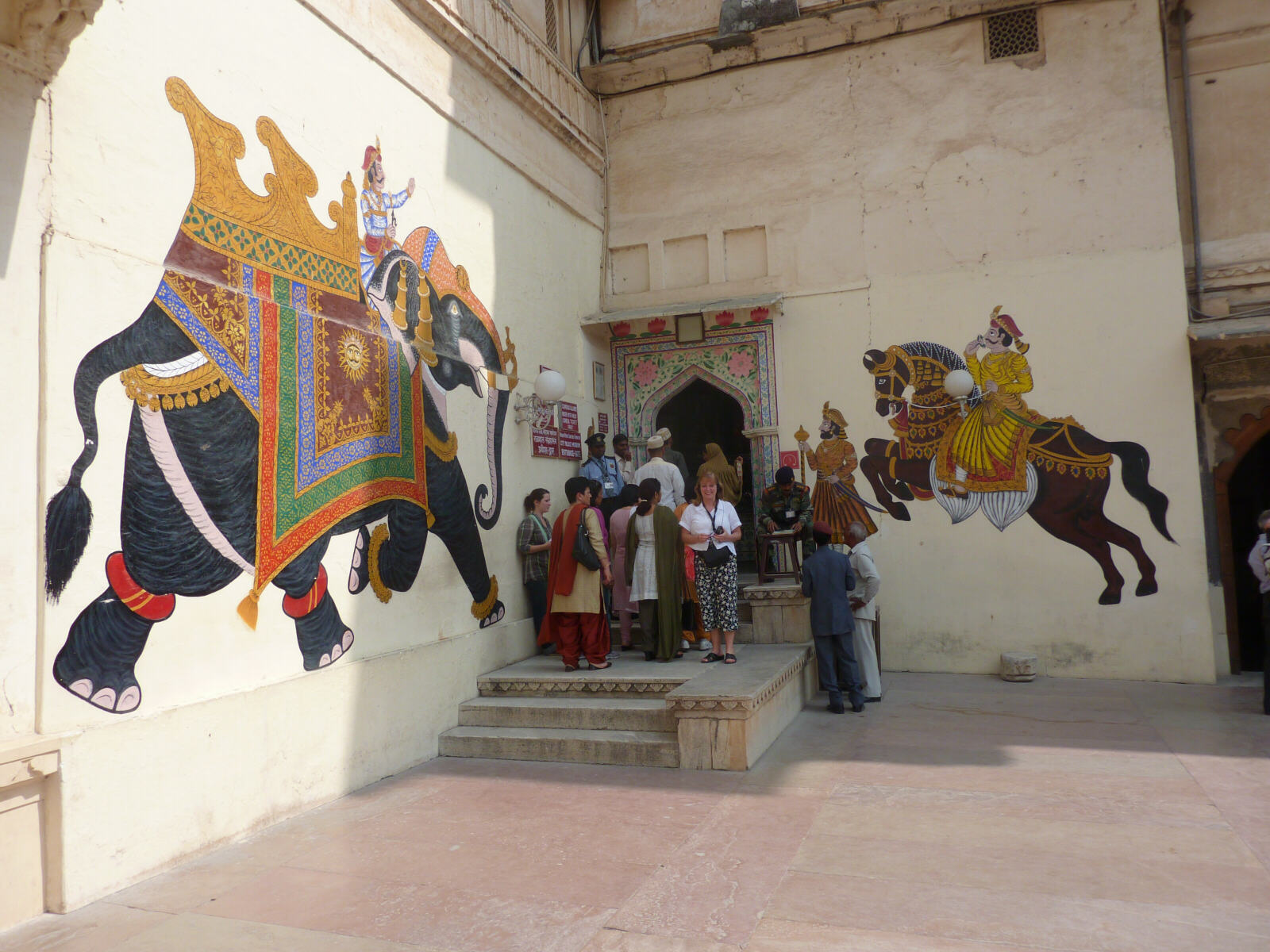
|
.... a window .... |
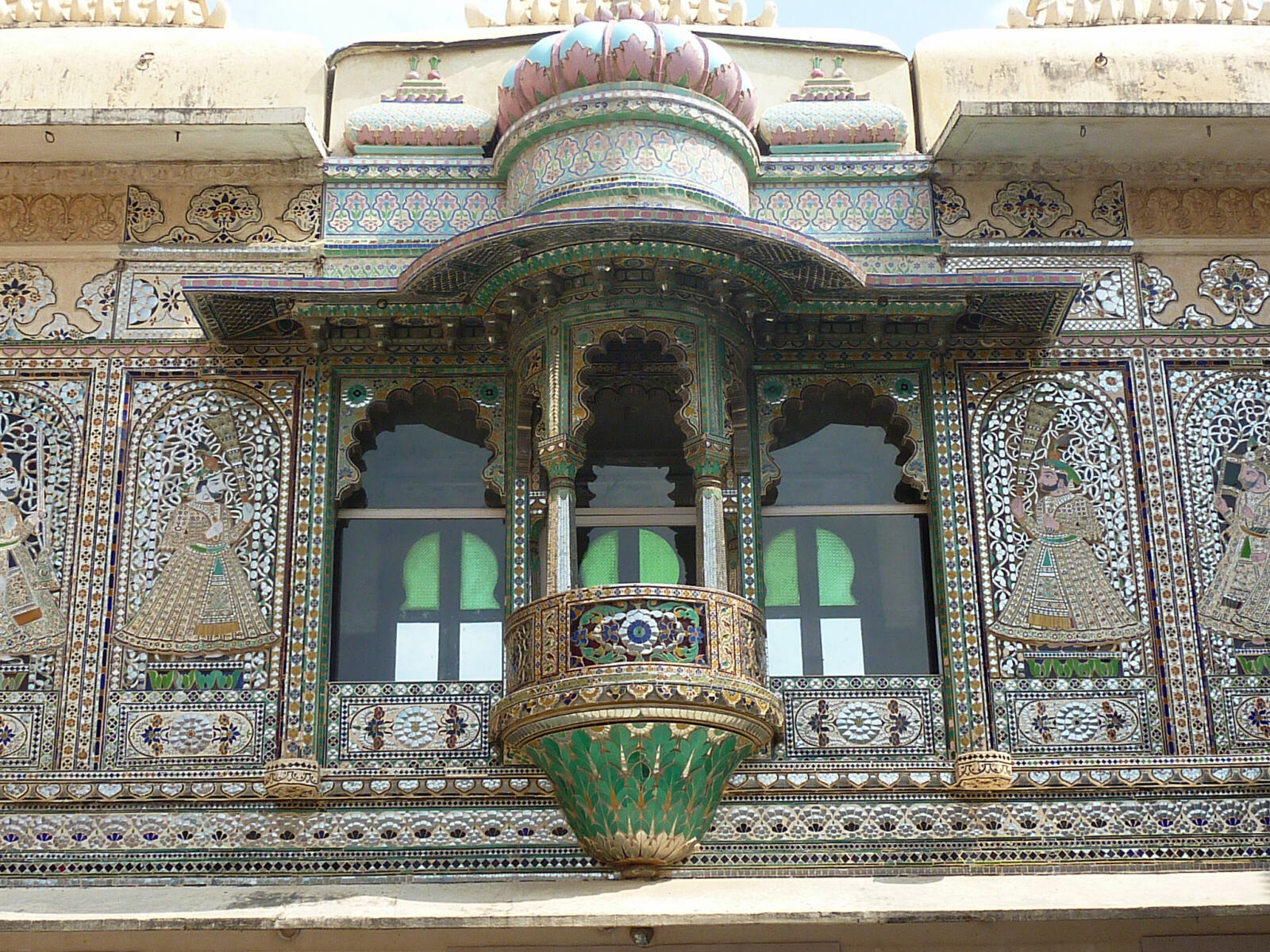
|
.... and a swing! |
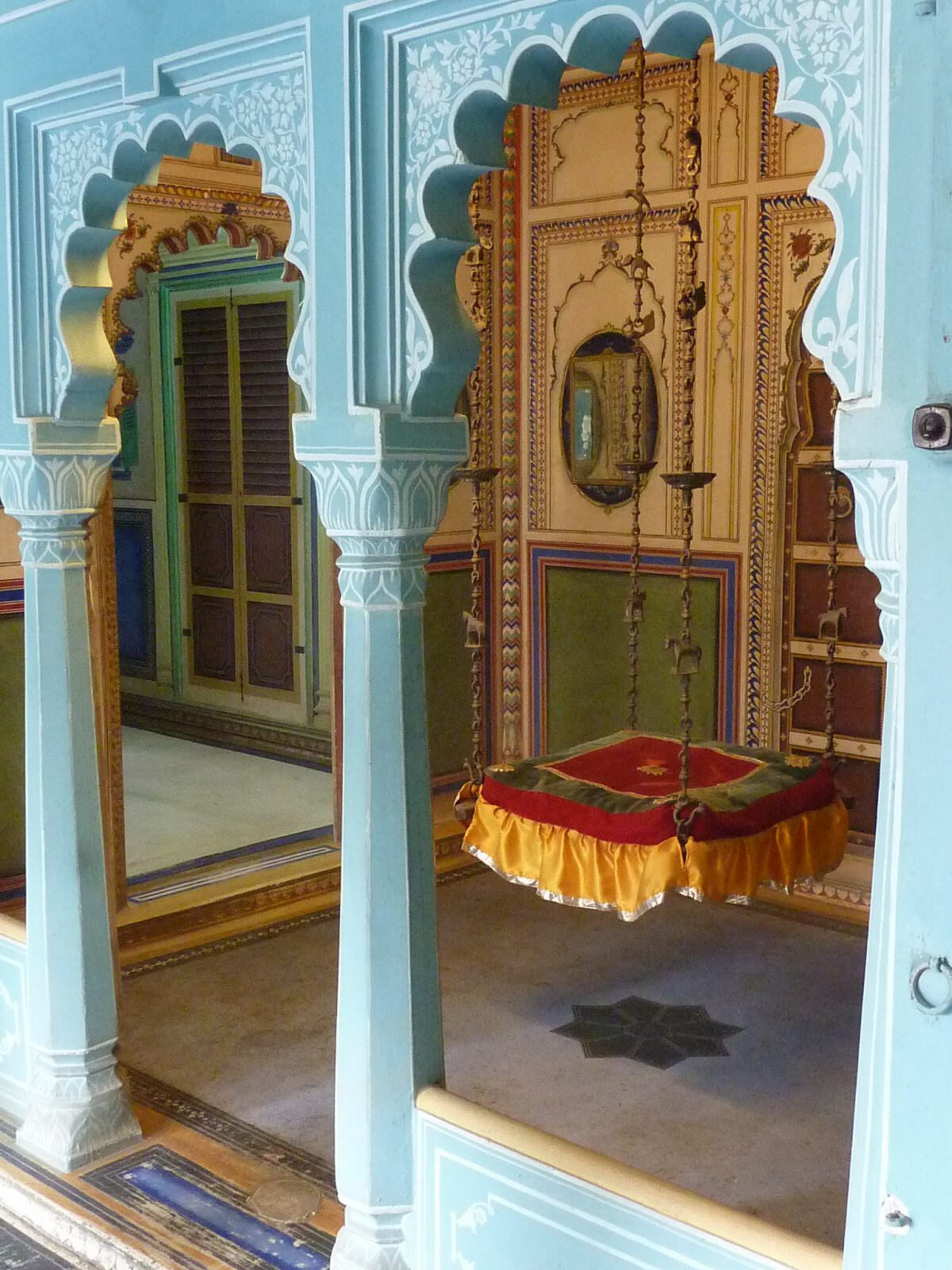
|
We walked through the palace complex yet again and went to the jetty for a boat ride on the lake. It was very pleasant and there were great views of all the palaces and havelis, but it was rather shorter than the advertised hour. We stopped at Jagmandir Island in the lake, which is occupied by yet another luxury hotel in a picturesque old palace, where we sat in the shady garden restaurant and had a sandwich and a drink rather spoiled by the incompetent service.
The Lake Palace hotel (below) is so exclusive you can't go there unless you've got a reservation (and heaps of money!) |
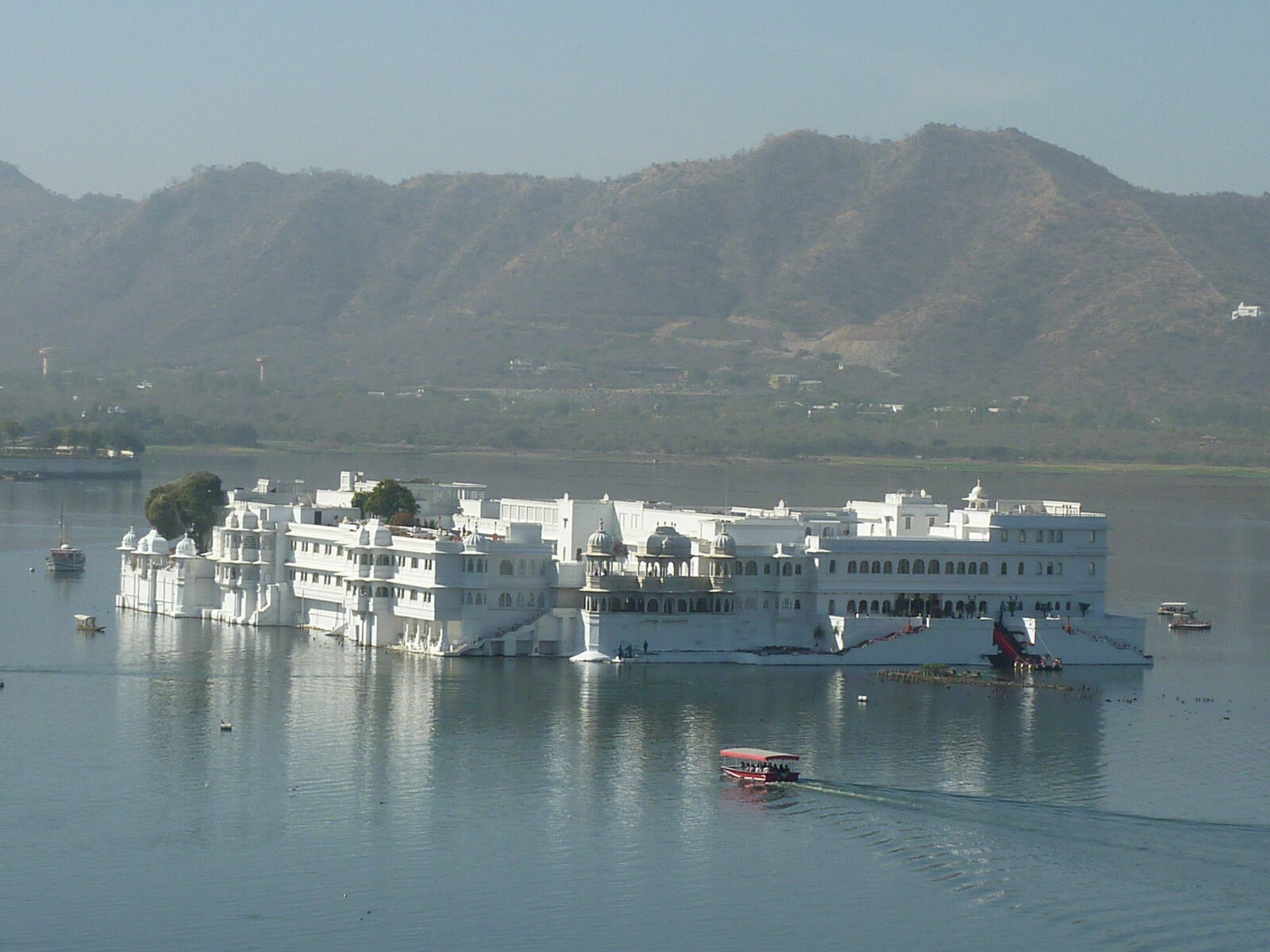
|
One day I walked to the clock tower and along Bara Bazaar and back through nameless back streets until I came out near the Whistling Teal where I had a refreshing soup and tea in their well-kept garden restaurant. This became my ‘oasis in the city’ and we went back several times for a refreshing drink – on one occasion monkeys were disrupting the peace and quiet by shaking the trees above the tented hookah-lounge. Sheila went for some pampering and had the full Ayurvedic massage (this time the masseuse was a woman, unlike in Mahabalipuram on a previous holiday when, after a massage by a masseur, she wasn’t sure whether to pay him or call the police!). She also went shopping and bought a marble doorstop after haggling for several days to bring the price down to a third of the starting price.
One day at 5pm we got a rickshaw and minibus tour up the Monsoon Palace, a few kms from town, perched on top of one of the jagged mountain peaks around Udaipur, and admired the fabulous views in all directions as the sun went down. |
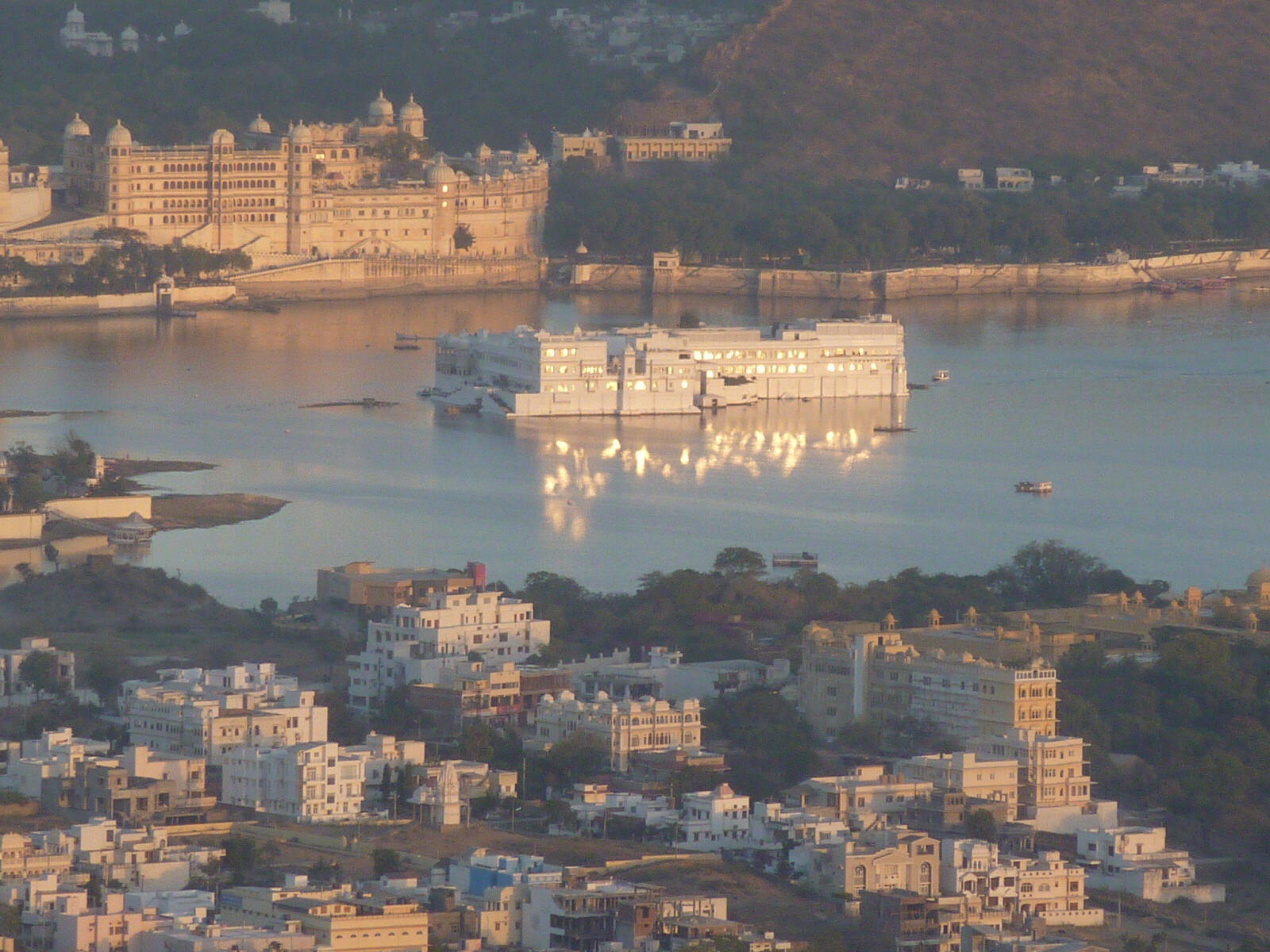
|
Sheila had a two-hour Indian cookery class run by the lady proprietor of our hotel and as the sun went down we sat with the other students on the hotel rooftop eating the delicious results of their labours. We finished the evening in another nearby restaurant with a rice pudding, watching the James Bond film ‘Octopussy’, much of which was filmed in the palaces around Udaipur.
It’s so difficult to choose where to eat in Udaipur – in Bundi there seemed to be few good places but here in Udaipur you can’t move for restaurants (both metaphorically and literally, because we’ve eaten so much!). One of our favourites was the Ambrai Restaurant where we had a couple of really tasty meals (smoked chicken curry, chicken tikka and a bucket of raita) with very nice Indian Sula wine (half bottle about 10 pounds), sitting at table 9, the prime position in the corner of the garden with (yet another) great view of the floodlit palaces and mansions around the lake.
Another day we went for dinner at the rather posh Jagat Niwas Palace Hotel in yet another haveli nearby in our Lal Ghat neighbourhood, and had an average meal in a stunning position in a window table in an alcove projecting over the lake with all-round views of the picturesque floodlit palaces. One evening we went to see the cultural dancing at the Bagore-ki-Haveli, then had soup and a lemon soda at the Little Prince restaurant by the bridge, while a marching band procession went slowly along the other side of the lake shore and fireworks went off all over the city – it must be someone else’s birthday! |
- Pushkar
|
Sat 20th. After room service breakfast (tea and toast, it’s a pure vegetarian restaurant) our car was waiting to take us for the six-hour drive to Pushkar. For mile after mile on leaving Udaipur (and through districts beyond) we went past marble shops, marble cutting works and marble storage yards. There were enormous chunks of marble on lorries and being pulled on camel-carts, and discarded shards of marble lying around everywhere. There was pure white, ordinary white, pink, green and yellow (only from Jaisalmer) marble. The marble that the Taj Mahal was built of came from here. We saw mountains that had been mined for their marble until there was none left. I was soon all marbled out but Sheila remained fascinated all the way. |
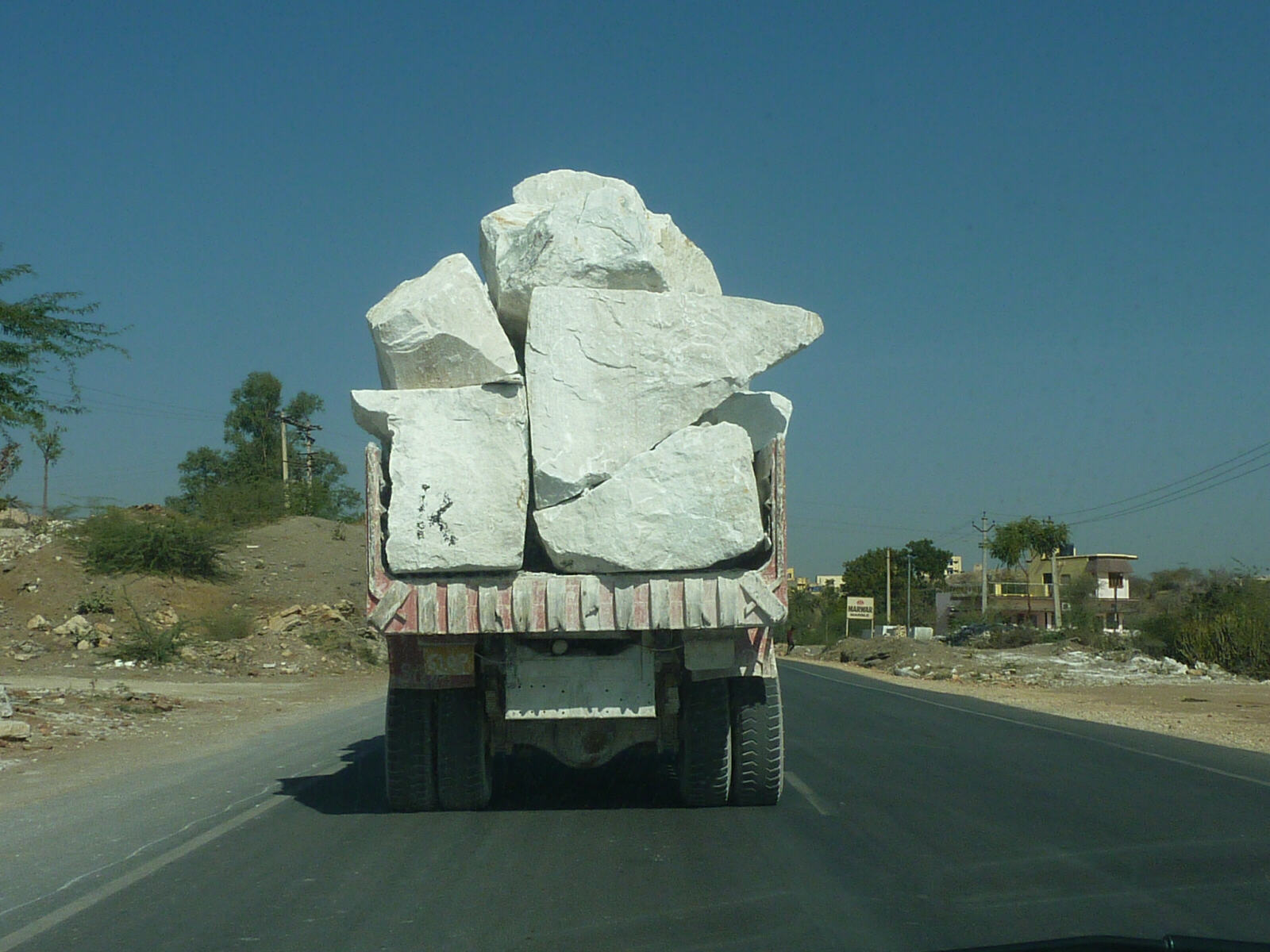
|
We stopped for chai and a masala dhosa at the midway point and arrived at the Seventh Heaven Haveli (hotel) in Pushkar which we had booked by phone. Seventh Heaven is a lovely old mansion built around a leafy central courtyard shaded by trees and draped in bougainvillea, but they had warned us they could only give us a room in the annex on the first night, then move us to one of the nice rooms in the main house tomorrow. To get to the annex we had to go up several flights of decorated marble stairs onto the roof, over onto the adjoining roof and then down a gloomy concrete stairwell to our grubby cell-like room – our spirits sank (but it’s only six pounds). We didn’t bother to unpack and went straight out to look around and walked along the main street, packed with tourist-oriented shops where Indian people were outnumbered by the hippies - slim, earnest people with their children, with dreadlocks or braided hair and Indian dress and decoration but with western faces. We went to the Bramah temple at the far end of the town, where the extraordinarily unfriendly security guards barked at us to leave our camera in a locker and searched through our bags roughly and menacingly. The temple is small and very active with worshippers queuing up for a quick puja with their God but by the time we got in we were not in the mood to appreciate it. The only consolation was that the worshippers seemed to be treated just as roughly by the guards, but they thought it was normal.
On the way back down the street we noticed ‘Out of the Blue’ restaurant with a very extensive menu and a real pizza oven and suddenly we felt the need to have pizza! We came back in the evening and it was very good, sitting in the airy, open restaurant one floor down from the roof, with extensive views over the town. As we walked back down Pushkar's main street afterwards we found that it had been converted into an open-air theatre with a festival in progress (in honour of Rama) with loud music and costumed dancers including one with a huge live snake draped around her (or him?), while priests (or at least men in white smocks) walked up and down the audience who were seated all over the street, showering them with marigold petals. |
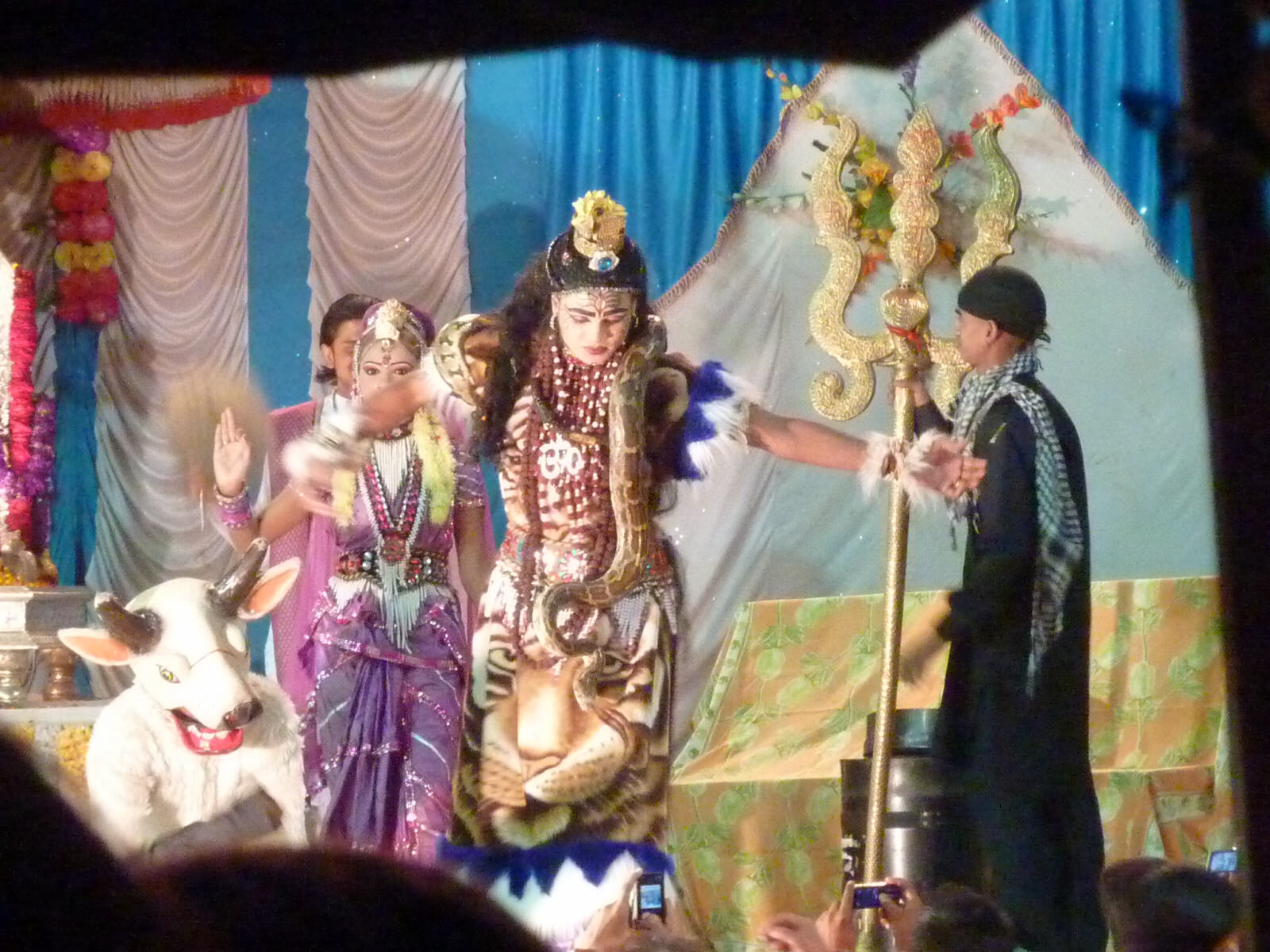
|
Sun 21st. We had breakfast and lunch and afternoon tea relaxing in the chairs and swings on different levels around the pleasant central courtyard at the Seventh Heaven. We moved into one of the very nice rooms in the main building (a bargain at 800 Rs) and were much happier. |
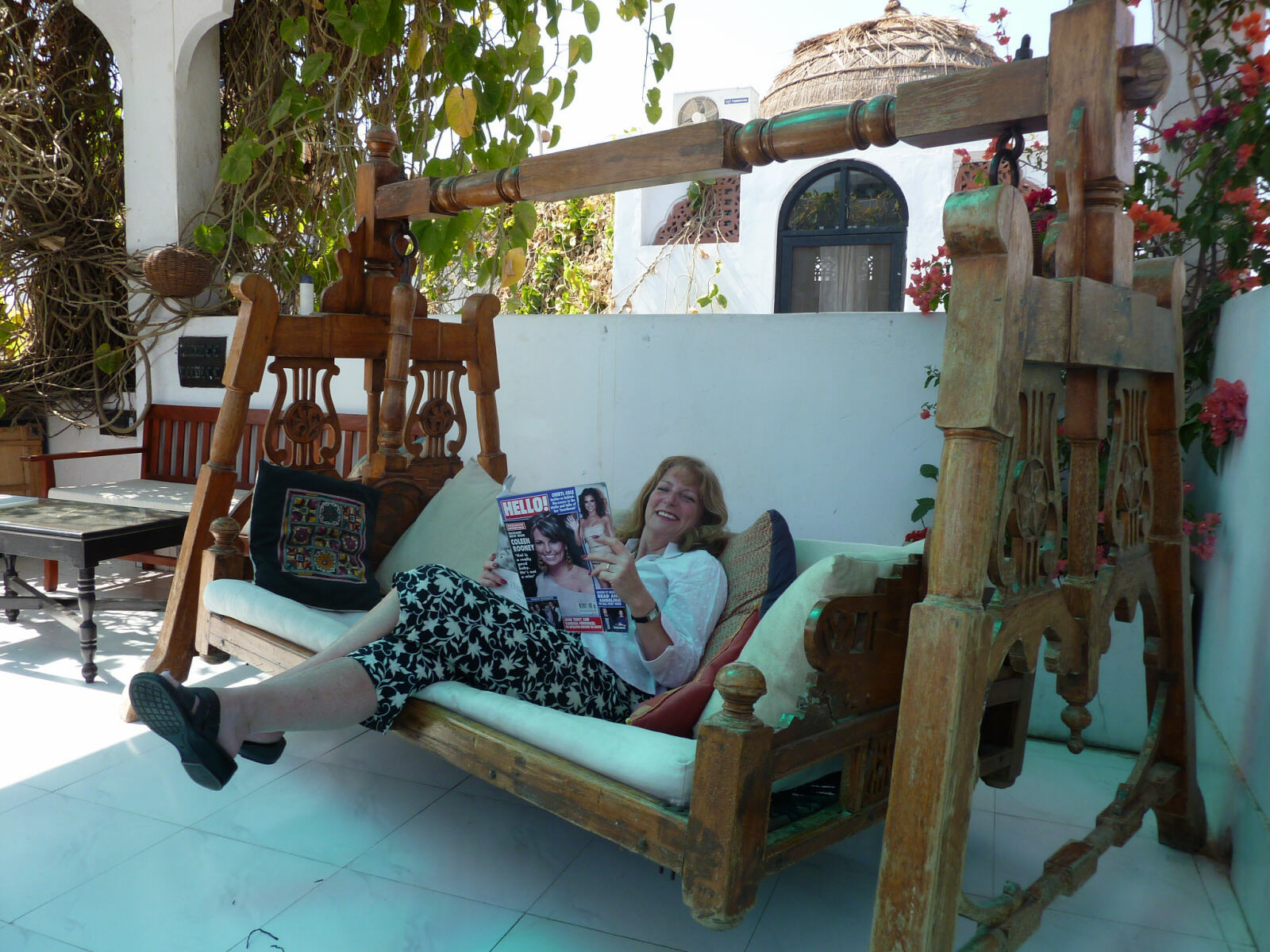
|
Out in the town Pushkar seemed much quieter and more relaxed today and while Sheila slept on one of the swings at Seventh Heaven I strolled around the streets and once round the lake and the bathing ghats with minimal hassle from priests and beggars. Unfortunately the lake has completely dried out which rather reduces the picturesqueness (as well as the opportunities for ritual bathing) but a couple of the ghats have constructed their own ‘swimming pools’ at the bottom of the steps so people could still perform their ablutions. |
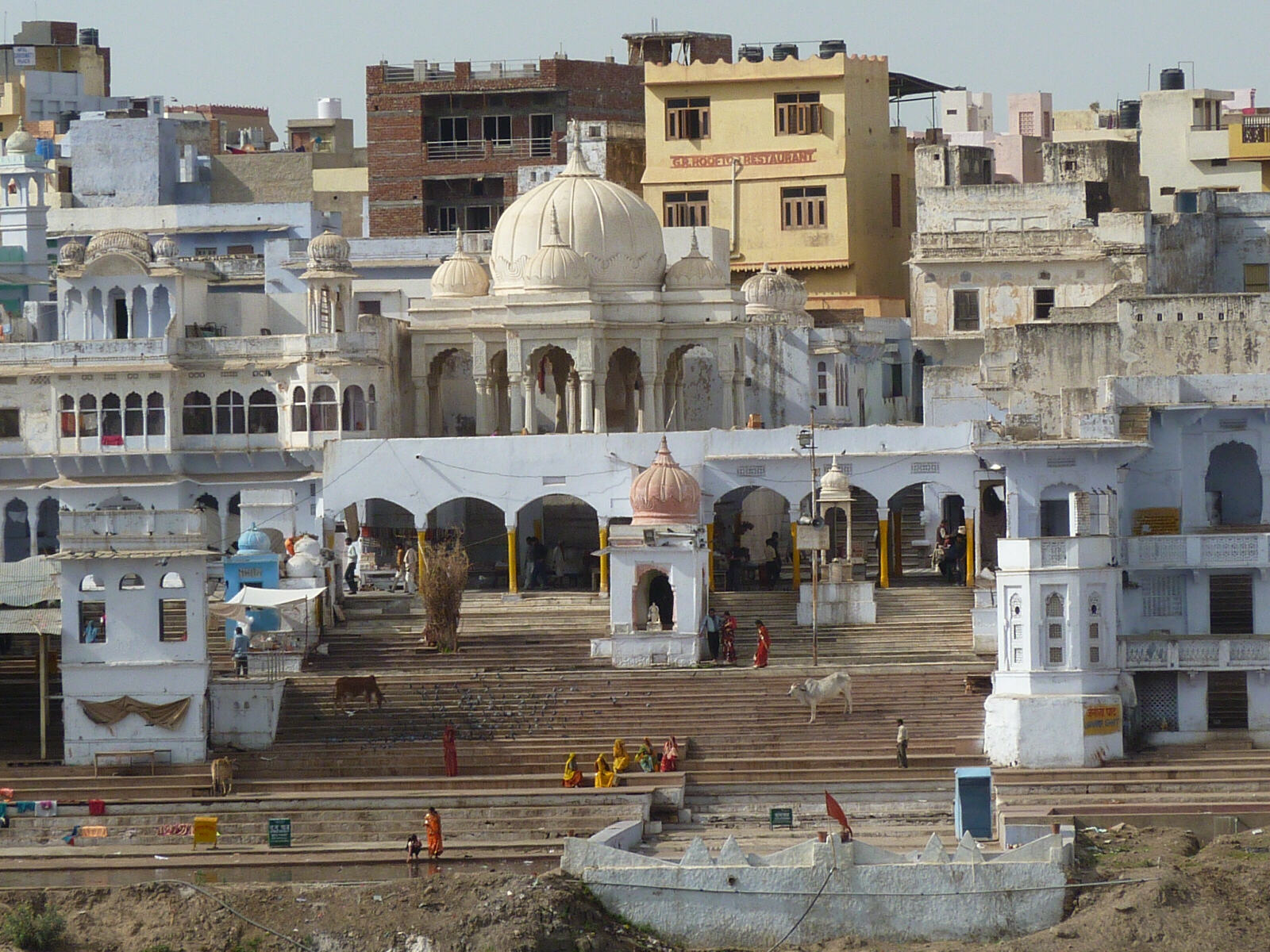
|
- Jaipur and Amber
|
Mon 22nd. Again we spent the morning relaxing around the courtyard of Seventh Heaven and had a ‘sizzler’ in the rooftop restaurant for lunch. Then we got the taxi to Ajmer station (Rs 250) and caught the express train non-stop to Jaipur. It was a ‘Jain Shatabdi’ class train, a genuine express which went at quite a rate, while they served us ‘afternoon tea’ all included in the ticket price. We went to Chitra Katha hotel which was very new, clean and bright but a little bit characterless after the historic old hotels we’ve been staying in (and rather expensive compared to the Pearl Palace hotel across the road, which is very popular and booked up weeks in advance). We went for dinner at the rooftop ‘Peacock’ restaurant at Pearl Palace which was very nicely decorated, and warmed by blazing log fires that they carried out and placed in the open areas. For the last three weeks we’ve had cloudless blue skies but now suddenly dark storm clouds blew up and as we sipped our beers we watched the lightening flashing across the city, followed a little later by a sudden dramatic hailstorm!
Tues 23rd. We went on an auto-rickshaw tour out to Amber, another impressive Rajasthani fortress and palace 11 km north of Jaipur. The palace audience hall was dazzlingly decorated with inlaid glass and mirrors but there was no furniture. |
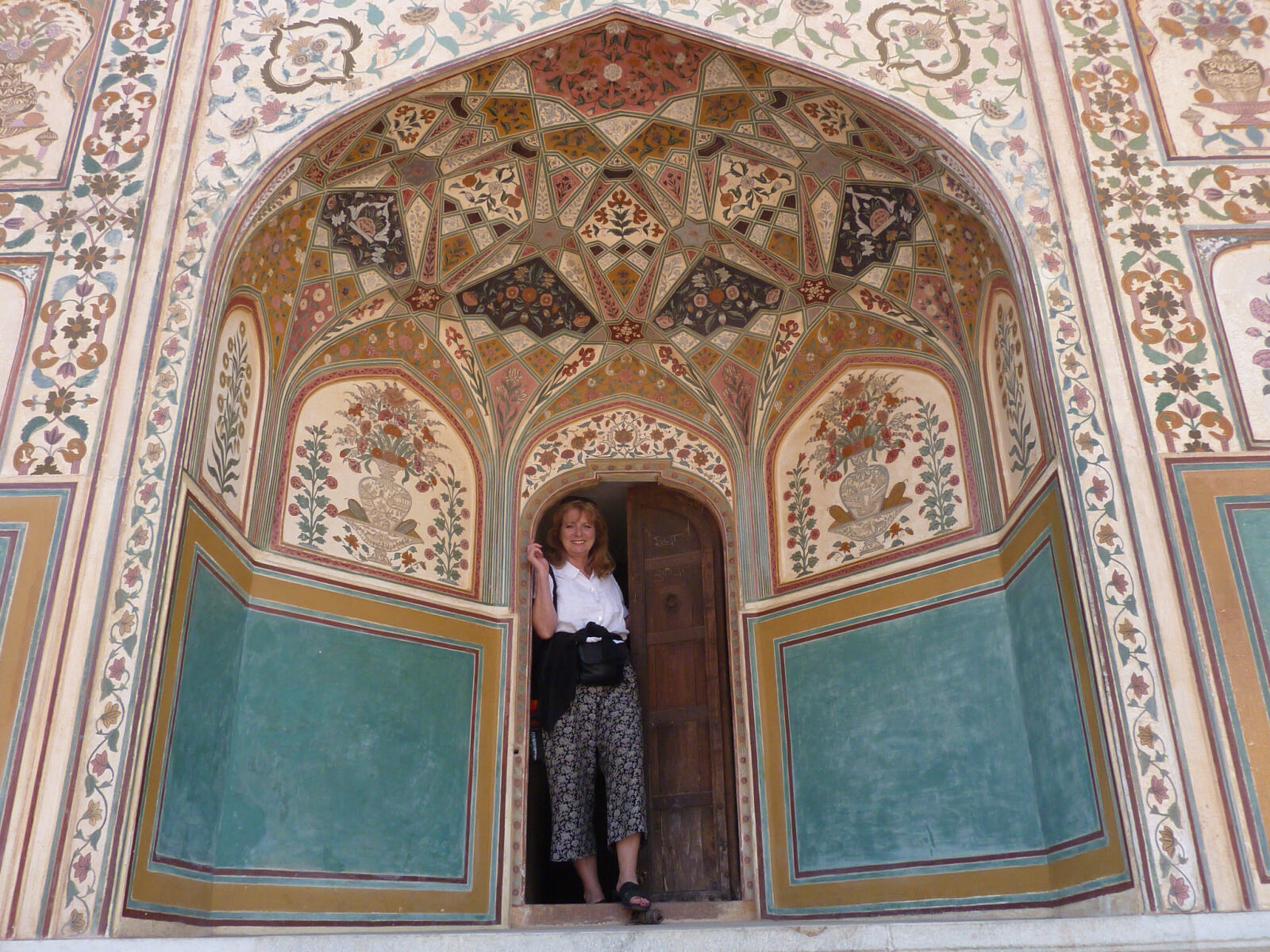
|
If you are too tired to walk up to the palace, other forms of transport are available! |
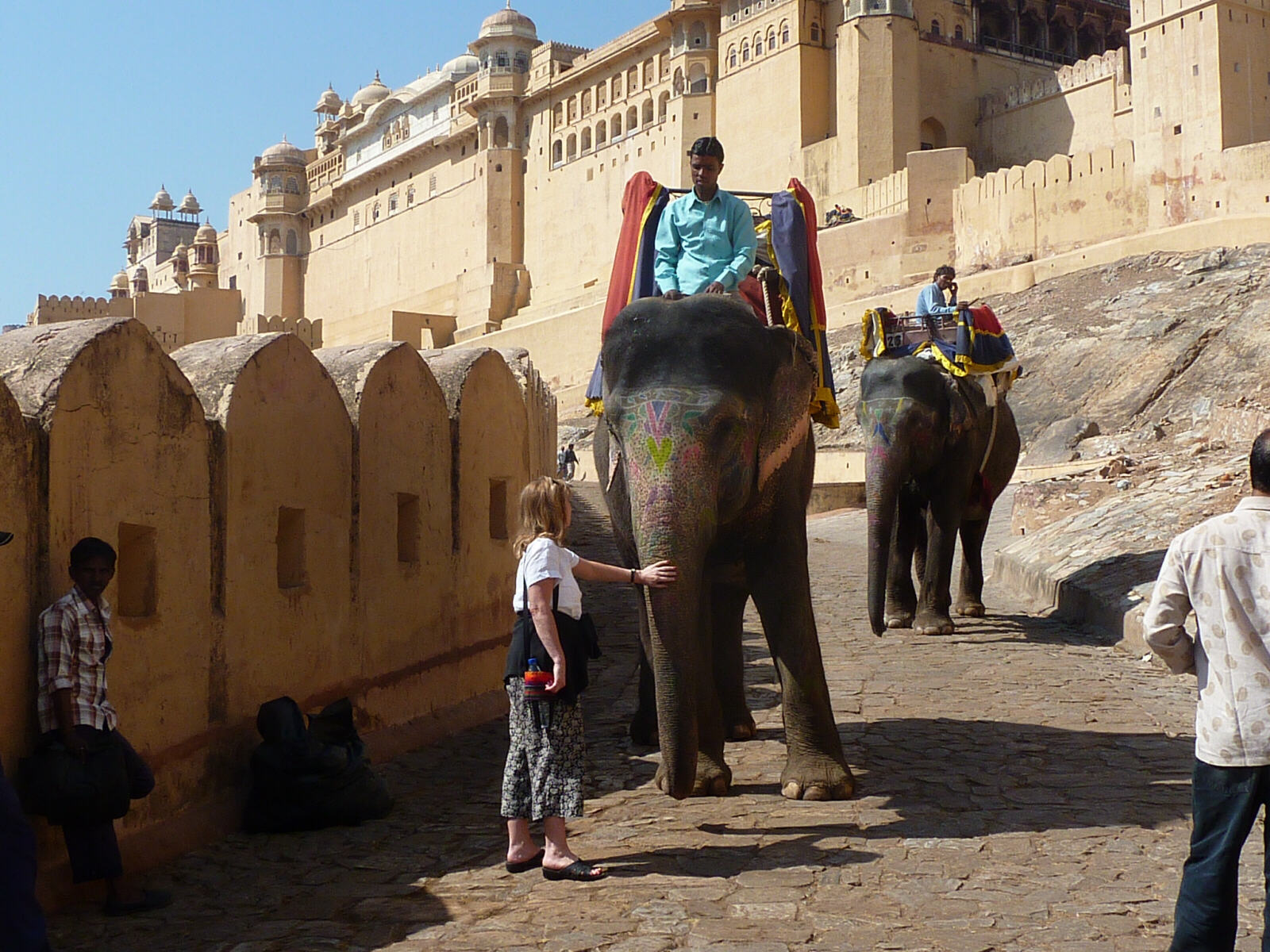
|
On the way back we stopped by a lake where they were offering elephant and camel rides but we didn’t venture onto one. |
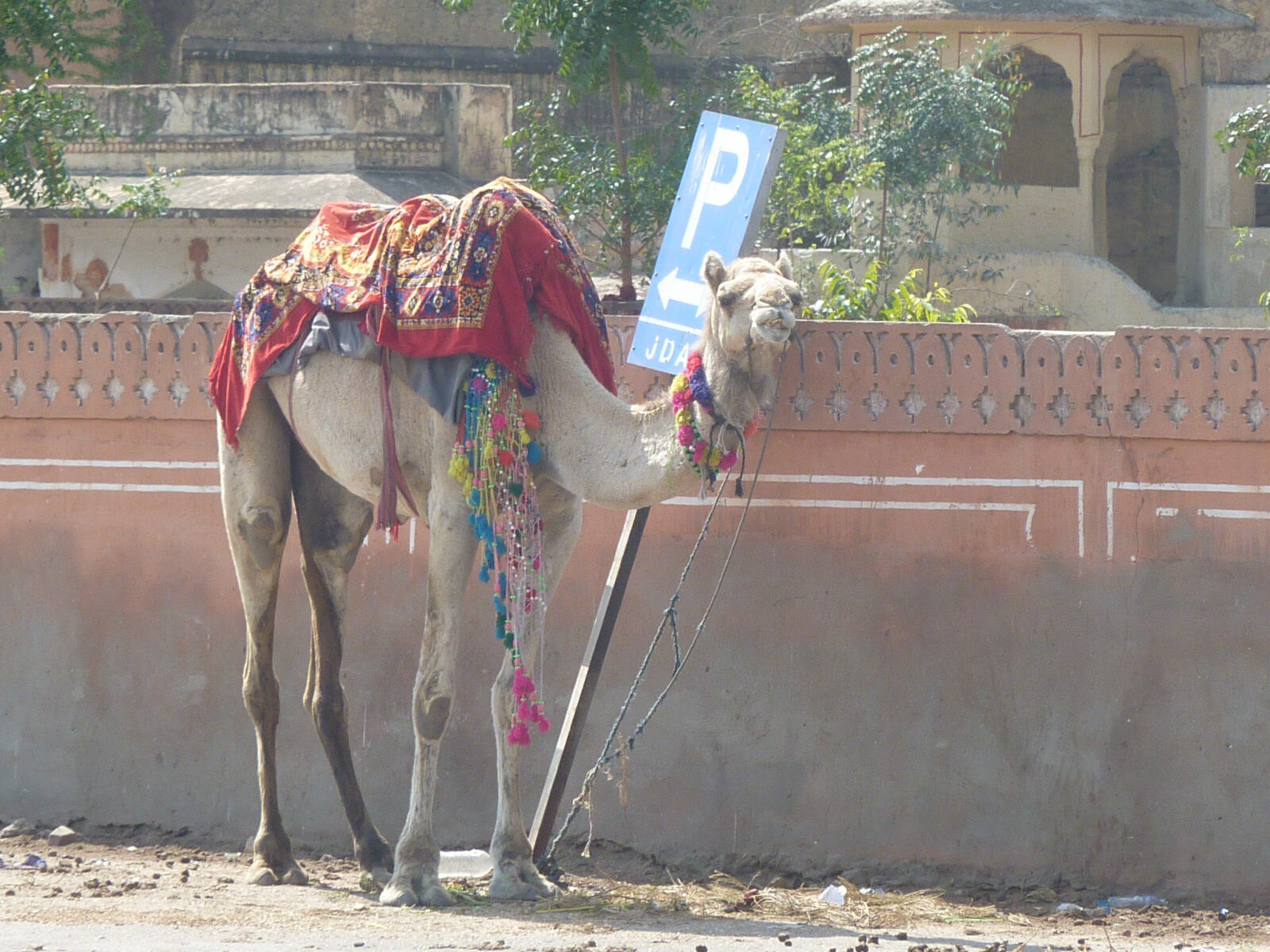
|
The only way to travel - the Hindustan Ambassador, designed in 1956 and still going strong. We stopped at the station to negotiate a car to Agra for the day after tomorrow, insisting on one of the old-fashioned Ambassadors - not very fast but comfortable and fun! |
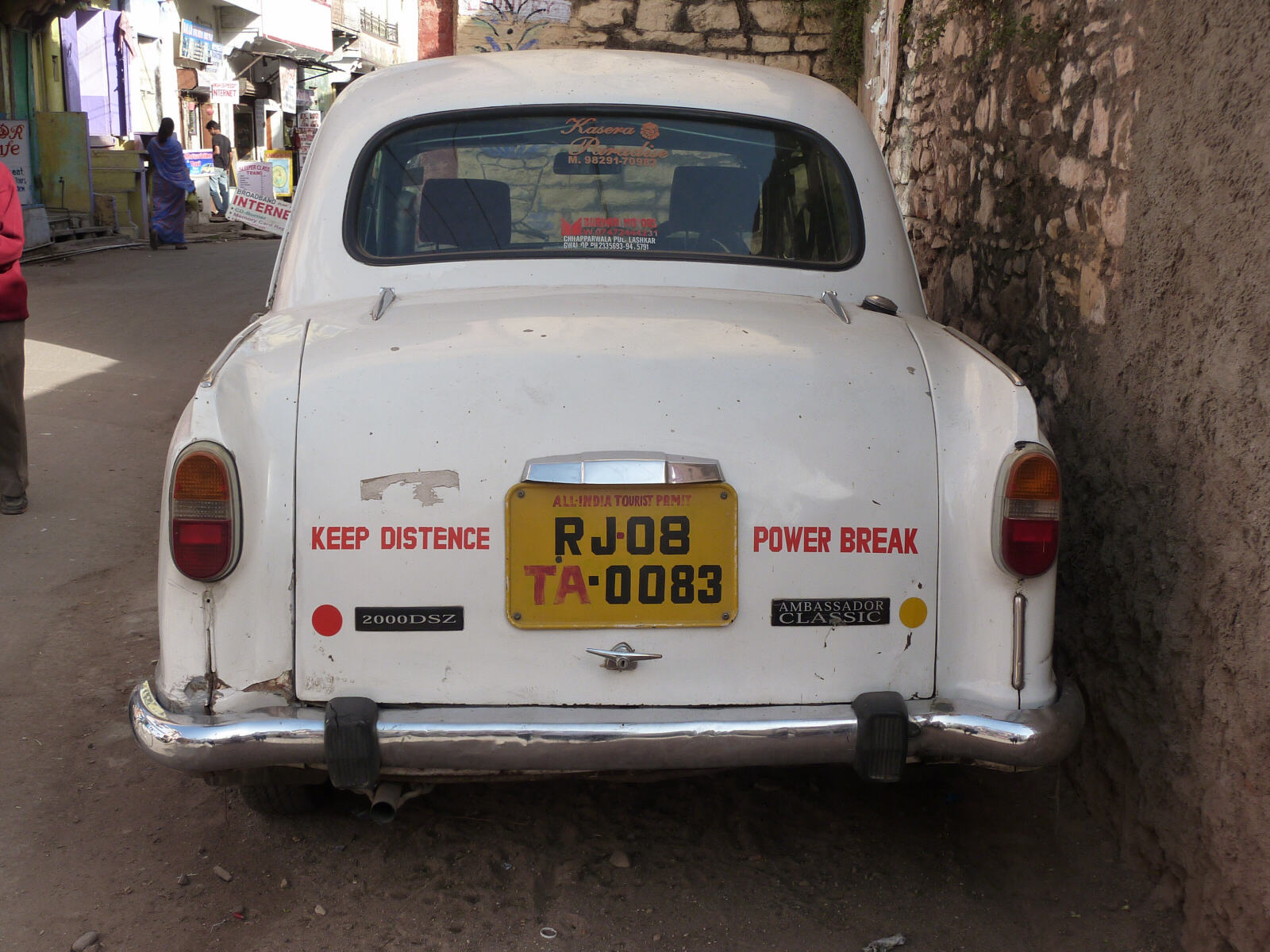
|
Weds 24th. We had a good day sightseeing in Jaipur. An auto-rickshaw dropped us in Panch Batti square (by Raj Mandir, the largest cinema in Asia) and we went on a (self-guided) walking tour through the bazaars, past marble works down little side alleys where they were chipping out elaborate temple monuments, past fabric shops and bangle makers, and a tiny little workshop down another side alley where a master lacquer maker showed us his photo album of him with Prince Charles, Indira Gandhi and various maharajas while his sons and daughters boiled and kneaded the blobs of lacquerware.
We admired the cow-dung section of Jaipur street market. Cowpats – how versatile they are and how under-used in England. They can be moulded into all shapes and sizes, from small plate-size to large dinner plates, large balls, small balls, large polo mint shapes and our particular favourite, a hollow ball the size of a tennis ball with another one inside that rattles when shaken. You can play catch or roll them along the floor, hours of fun for all the family when there is nothing on the television. Primarily their use is for fuel for cooking fires - we didn’t buy any however because there’s no room in our suitcase. In the villages that we drove through we saw them stacked in a variety of ways and some were stored in cowpat houses with cowpat walls. The walls were decorated with stripes or zig-zags or fingerprints. The possibilities are endless but I hope it’s not putting you off your lunch. |
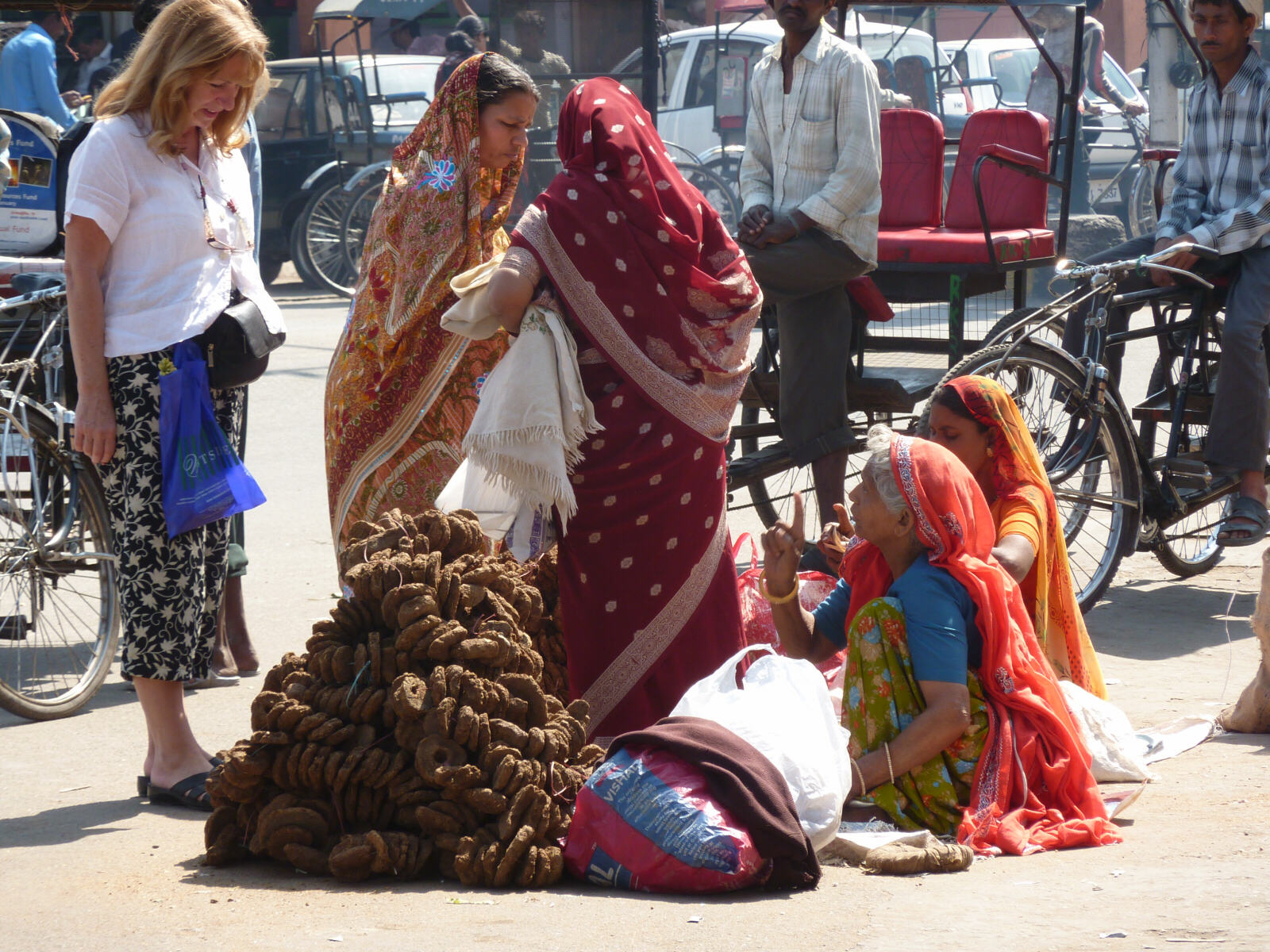
|
We saw a well-loaded bicycle in a street in Jaipur.
|
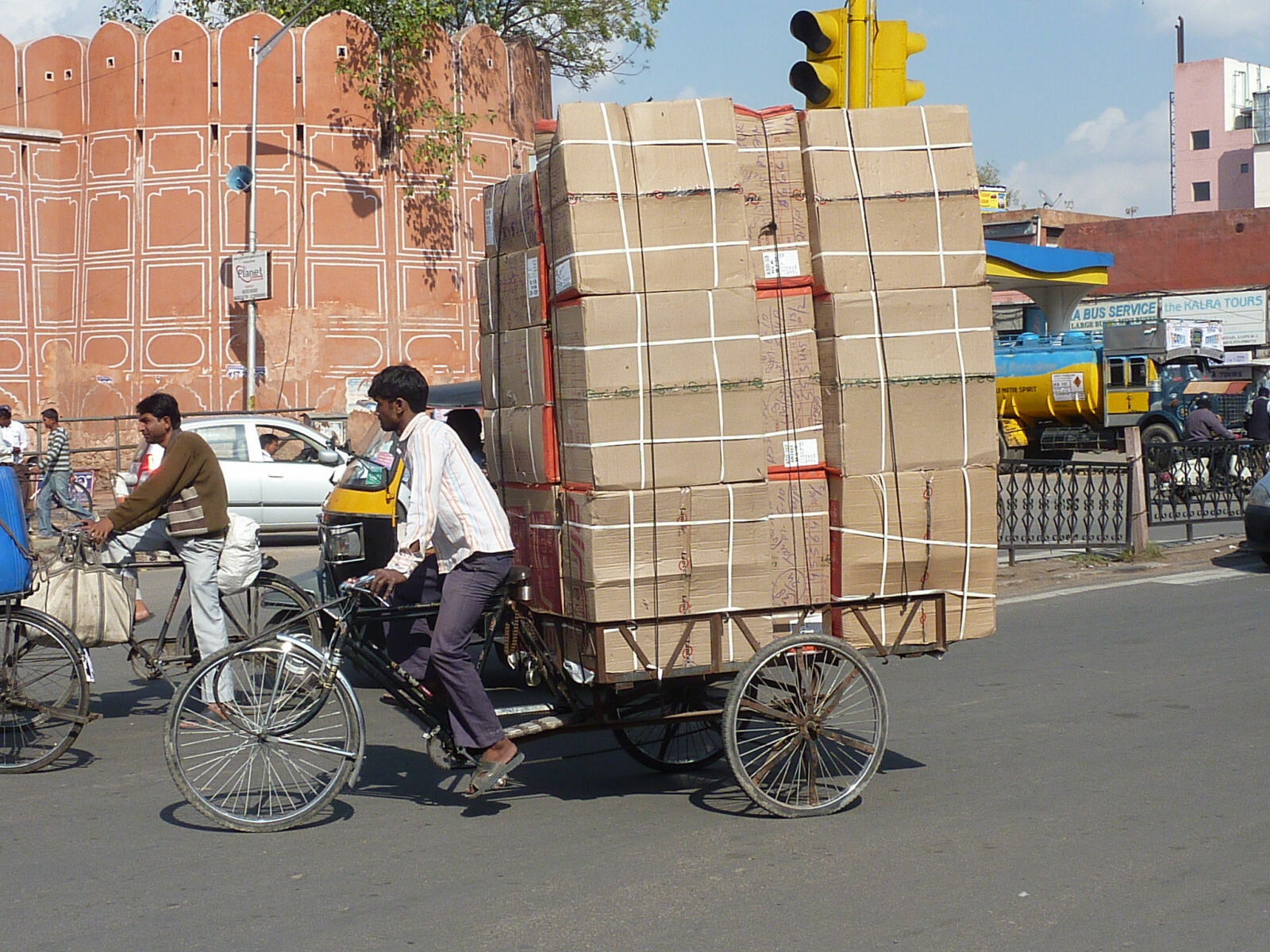
|
We walked through archways into the area where the palaces are and went to the Royal Palace, another picturesque one but all on one level instead of up and down multiple staircases. Then we went to the nearby Hawa Mahal (Palace of Winds) with the five-storey pink facade with all the delicately carved windows that you see on all the tourist brochures of Jaipur, to find that it’s actually only a few feet thick, with another ‘façade’ on the other side. The ‘pink city’ of Jaipur is actually painted pink, not built out of pink stone. |
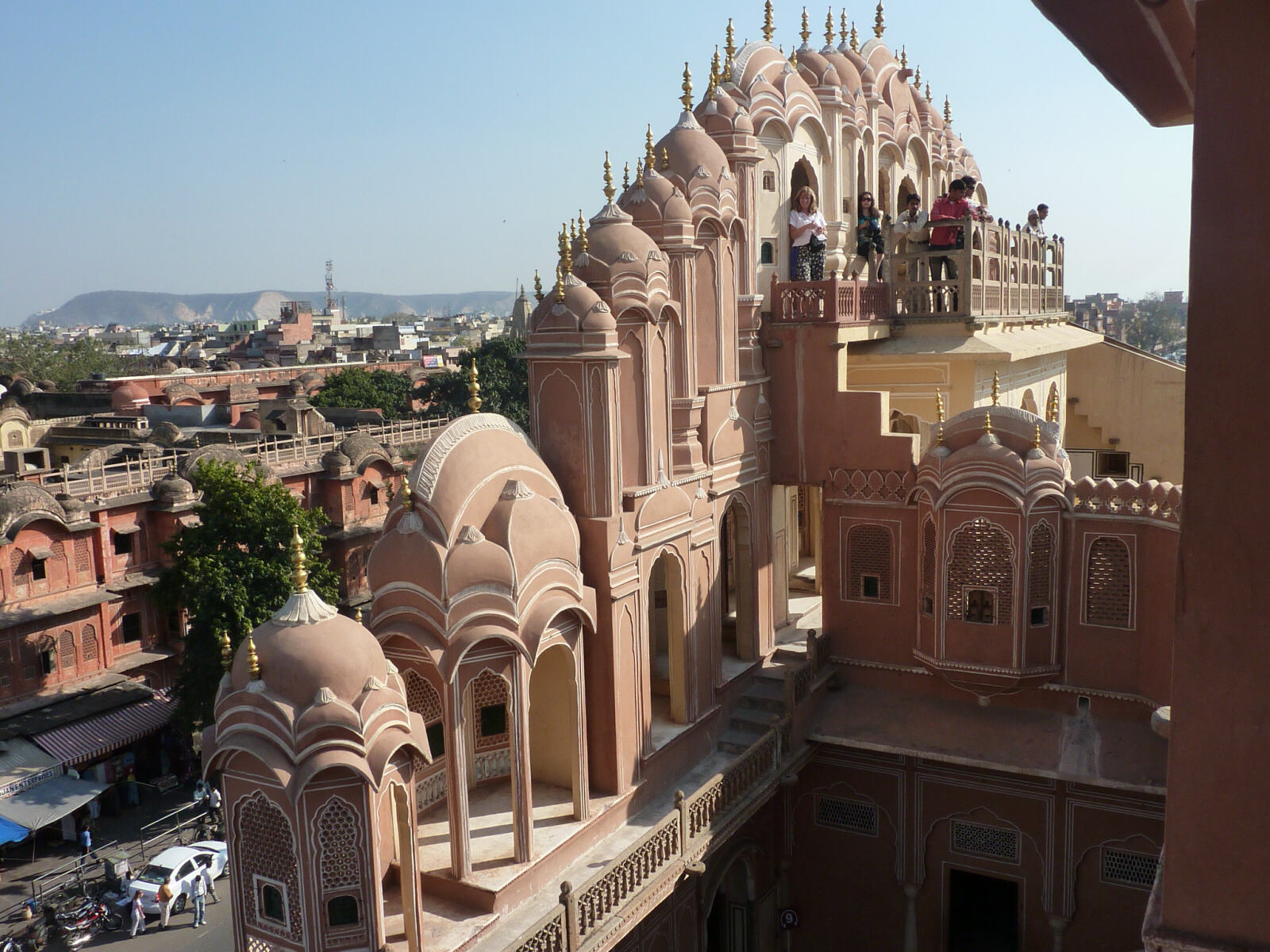
|
We got an auto-rickshaw to the other extreme, a modern shopping mall for Sheila to stock up on nail varnish, then had a look at the charmingly old-fashioned Narain Niwas Palace hotel with its Raj-style veranda and dining room, set in lawns where peacocks were strolling. Dinner was two wonderfully tasty curries at the Peacock restaurant again. |
Uttar Pradesh state
- Fatehpur Sikri
|
Thurs 25th. We set off in our Ambassador car for the ride to Fatehpur Sikri and Agra (Rs 4,000), stopping to look at sandstone cutting and carving works along the way. We went through interesting countryside including lots of fields of asparagus which is unfortunately not in season at the moment. Much of the road was dual carriageway which runs straight through the middle of villages (there are no such things as by-passes) so the road was still full of people and animals ignoring the traffic. On these tourist routes the half-way stops are at grossly over-priced pretentious restaurants in ‘motels’ with tacky gift shops rather than the chai stall and samosas that we prefer. We stopped at Fatehpur Sikri to see the palace .... |
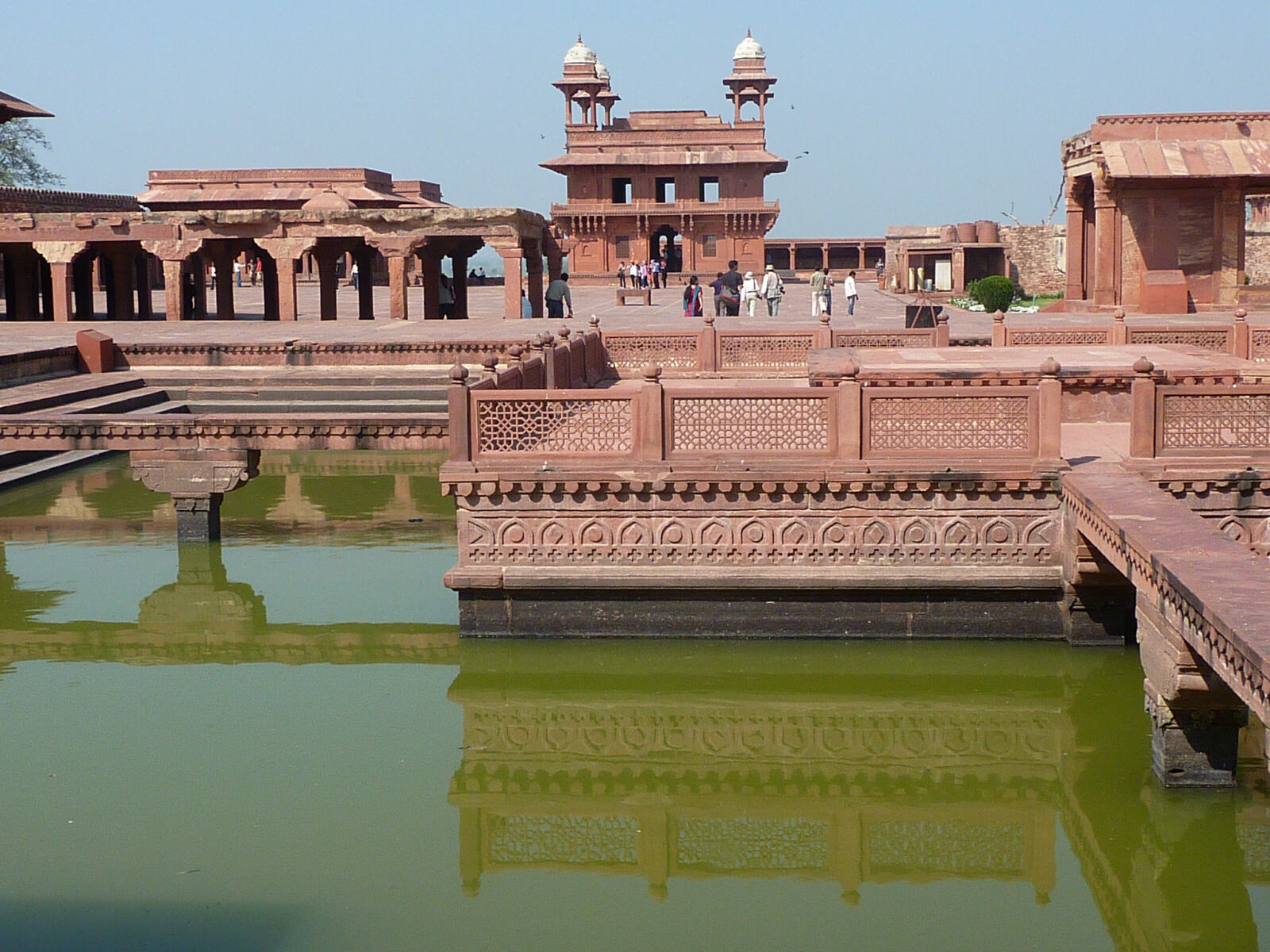
|
.... and the Mosque.
|
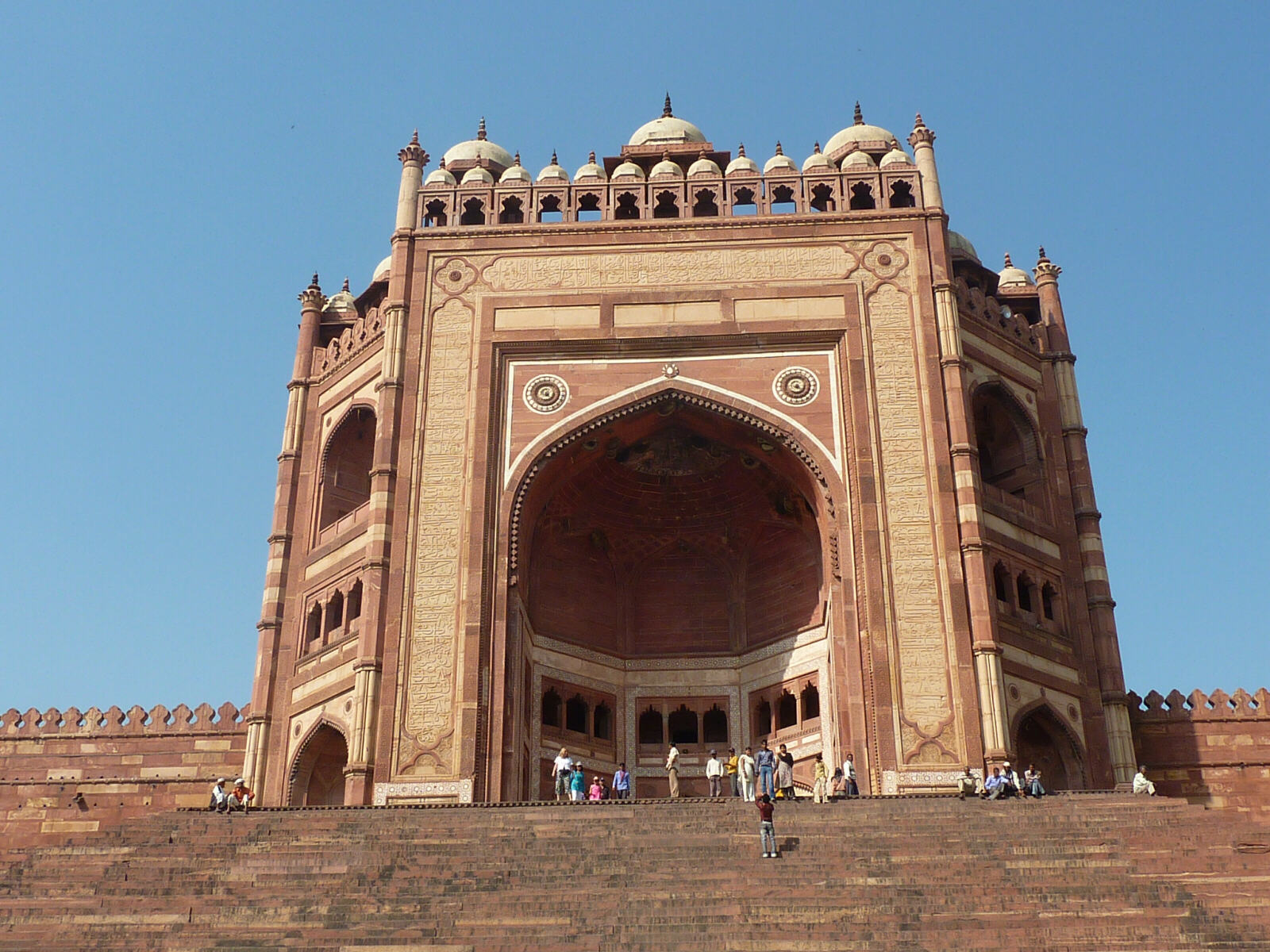
|
The palace, mosque and ruins at Fatehpur Sikri were very impressive but the experience was spoiled by nagging, persistent motor-mouthed vendors who followed us everywhere and would not stop whether we ignored them, asked them nicely to leave or eventually threatened them with violence. It’s a pity we couldn’t hire bamboo sticks to beat them off like the monkeys in Bundi. It was the same in Agra near the Taj Mahal which is a shame, because it completely destroys the ambience and this is all that some visitors see, and they must think the whole of India is like this. |
Agra and the Taj Mahal
|
When we arrived at East Gate Road in Agra we couldn’t drive to the Sheela Hotel because it’s in the pollution-free zone around the Taj Mahal, so we had to load our cases onto a cycle-rickshaw to complete the journey. The Sheela has a lovely garden to relax in but the rooms are rather cell-like. It was too late to go into the Taj but we walked down the little road beside it to the river bank and had a wonderful view of the back of the Taj at dusk. As well as being beautiful it is just huge – you don’t realize the sheer scale of it from the pictures. It was wonderfully peaceful on the river bank away from all the touts and vendors, with only a handful of other tourists and a boatman offering boat rides who actually took ‘no thank you’ for an answer. Unfortunately the restaurant in the attractive garden in the Sheela does not serve beer so we walked some way up the road to the Taj Plaza hotel’s rooftop restaurant (which could be really nice but is just a neglected empty space with plastic tables and chairs and washing hanging out to dry around it – they should have copied the Peacock rooftop restaurant in Jaipur). The food was very good, though.
Fri 26th. The Taj is closed today so everything seems more relaxed, the hasslers are having the day off. After breakfast in the pleasant garden at Sheela hotel we went by cycle-rickshaw to the Red Fort and had a walk round the impressive palaces, fortifications and mosques inside, including the white-marble palace where Shah Jehan could gaze out at his Taj Mahal when he was imprisoned by his scheming son. |
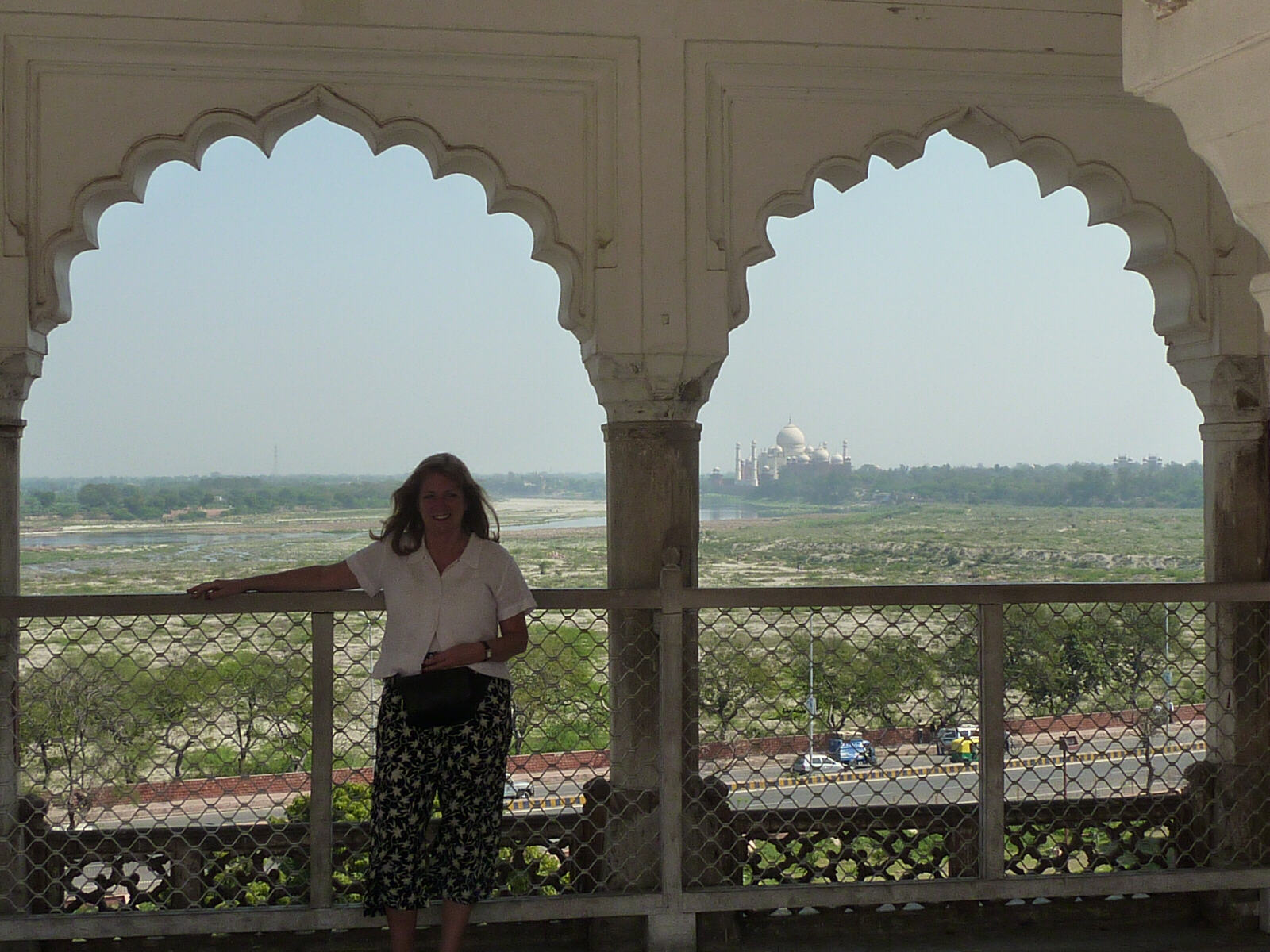
|
We returned to East Gate Road by horse and cart just for a change. Hotel Sheela was full (and anyway the bathroom had an open vent to the next room’s bathroom where the occupants spent most of the morning making the most amazing hawking and spitting noises) so we moved to a Taj-view room at the Taj Plaza hotel down the road. In the evening we walked down to the river again and had a gentle boat ride over to the other side to see a fabulous view of the Taj Mahal reflected in the river at dusk. |
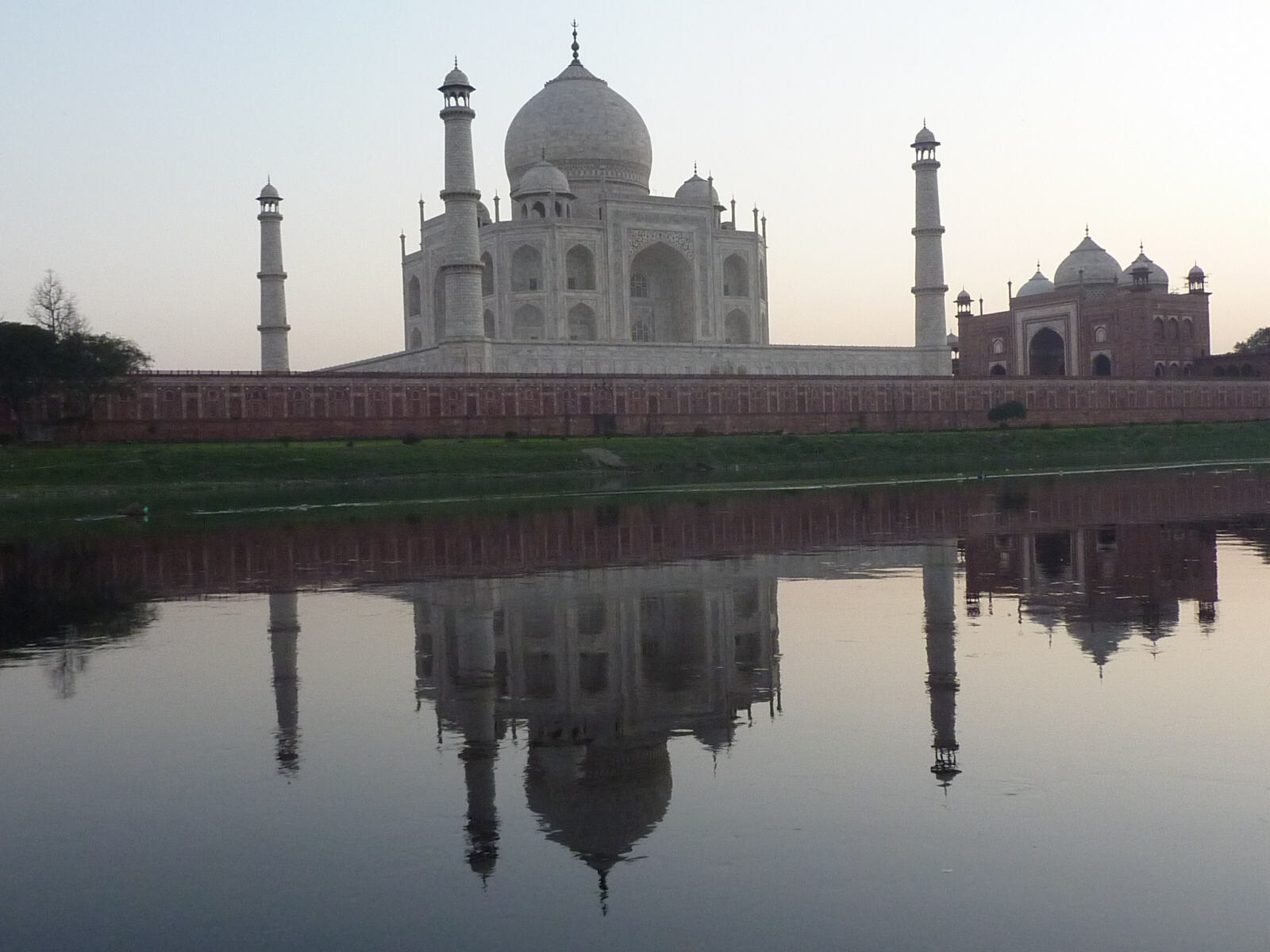
|
Sat 27th. We dragged ourselves up before dawn to get an early start at the Taj Mahal. Saturday is a popular day for it and after buying our ticket we joined the hour-long queue to go through the tight security into the Taj compound. Once again the sheer scale of everything strikes you – from the first courtyard you go through the huge entrance gate into the gardens where hundreds of people are taking the classic photo of the Taj reflected in the ornamental watercourses. We wandered slowly through the gardens amongst the crowds of Indians and tourists, enjoying the atmosphere and from time to time looking up and thinking – wow, that’s the Taj Mahal over there, isn’t it big! |
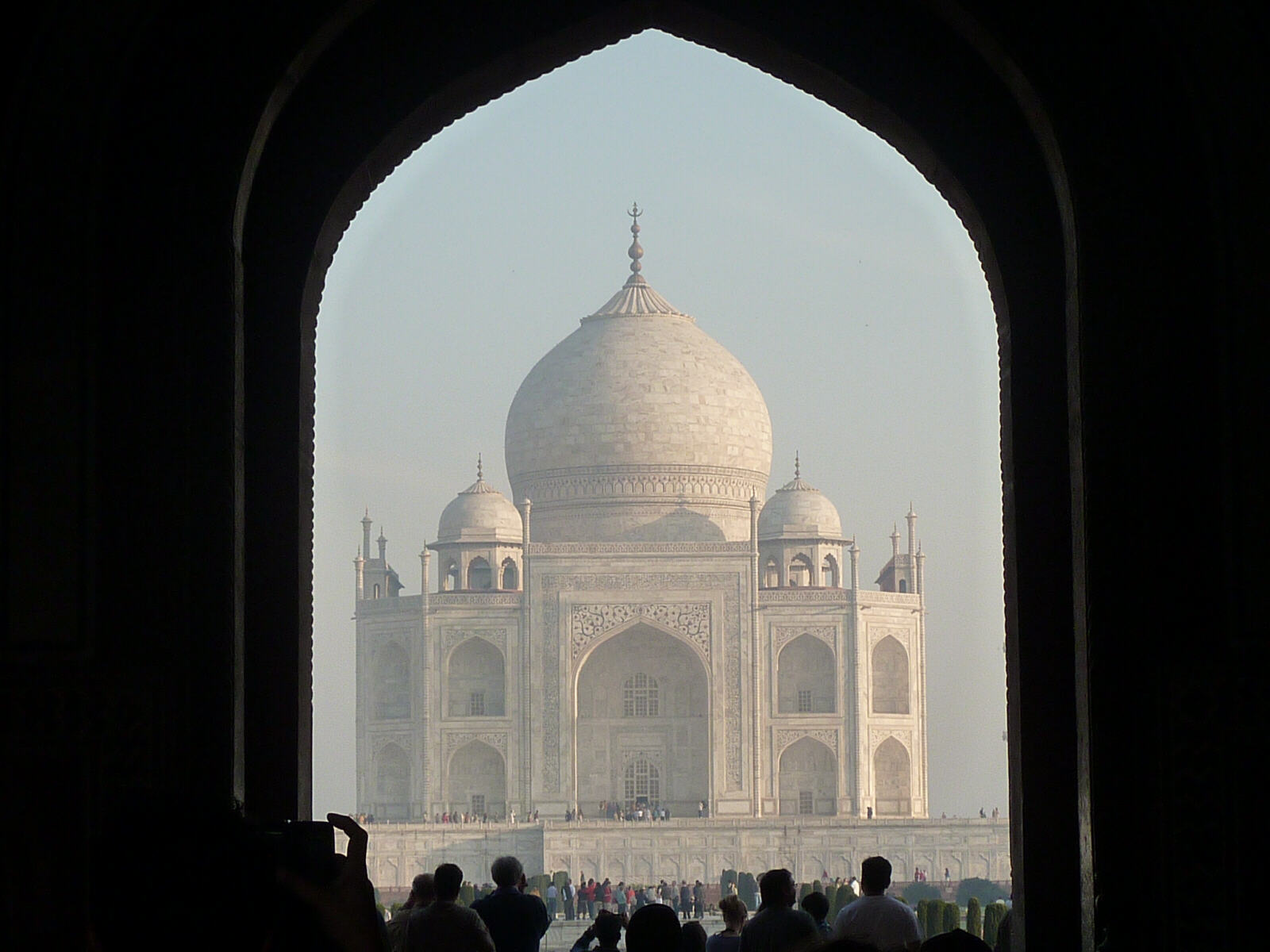
|
By the time we got to the Taj mausoleum itself huge numbers of Indian people had come in and a long queue had formed to get inside through the tiny entrance door. Many of the Indians were pilgrims from villages outside the city who were on a tour of the Hindu holy sites and making a ‘side trip’ to the Taj just to see it (Indians pay 30 pence to get in, foreigners pay 10 pounds for a one-time entry, so it’s a cheap day out for local people) and of course the villagers had no concept of queuing, so a couple of soldiers were constantly trying to stop breakaway groups surging forward past the queue, or skipping from one side to another as the queue snaked back on itself. The soldiers kept hitting them with sticks to keep them in line but they’re tough blighters and didn’t seem to feel it. |
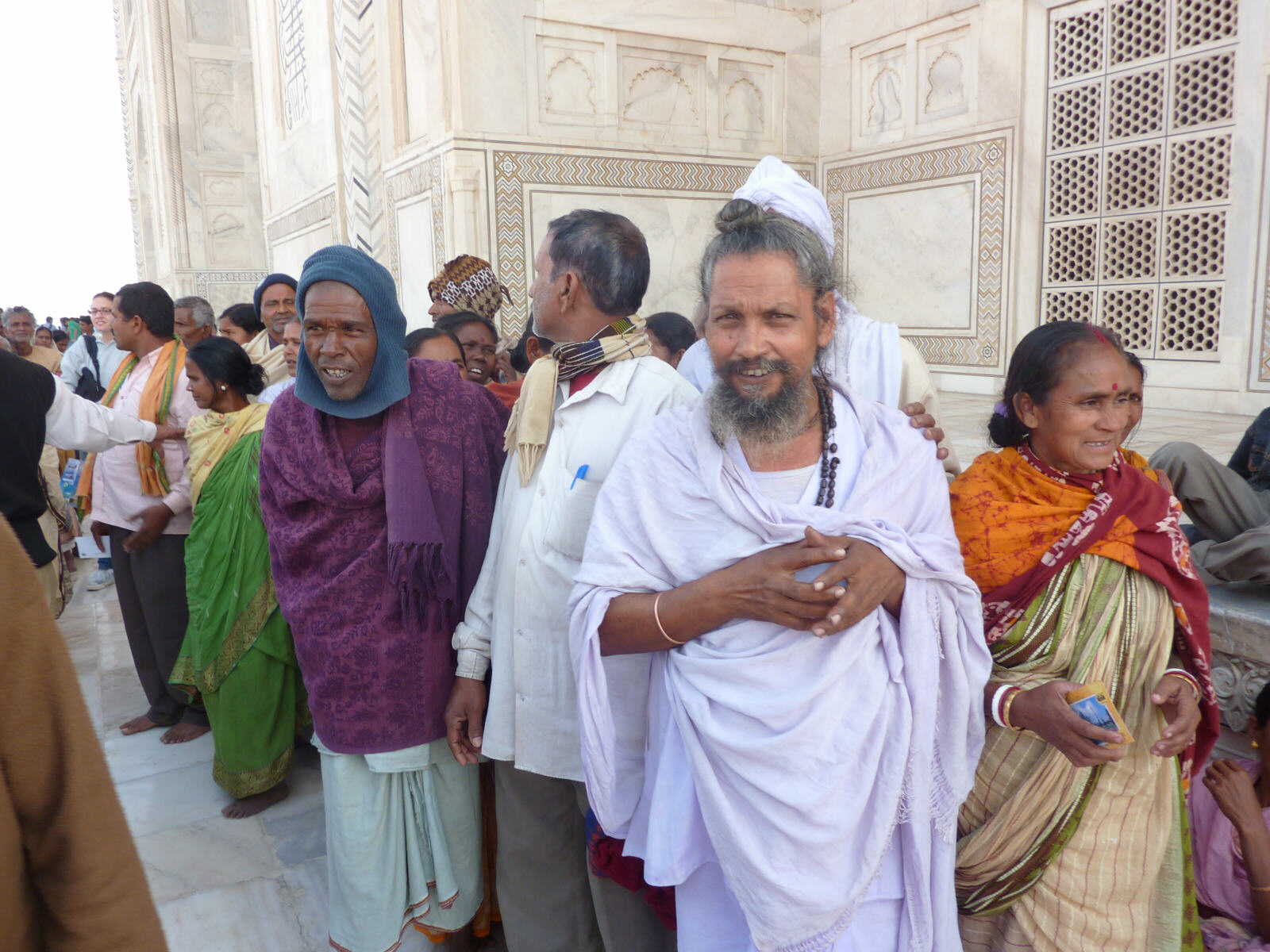
|
You have to follow the Indian way of queuing by crushing right up to the person in front of you, because if you leave the smallest gap someone will be in it. |
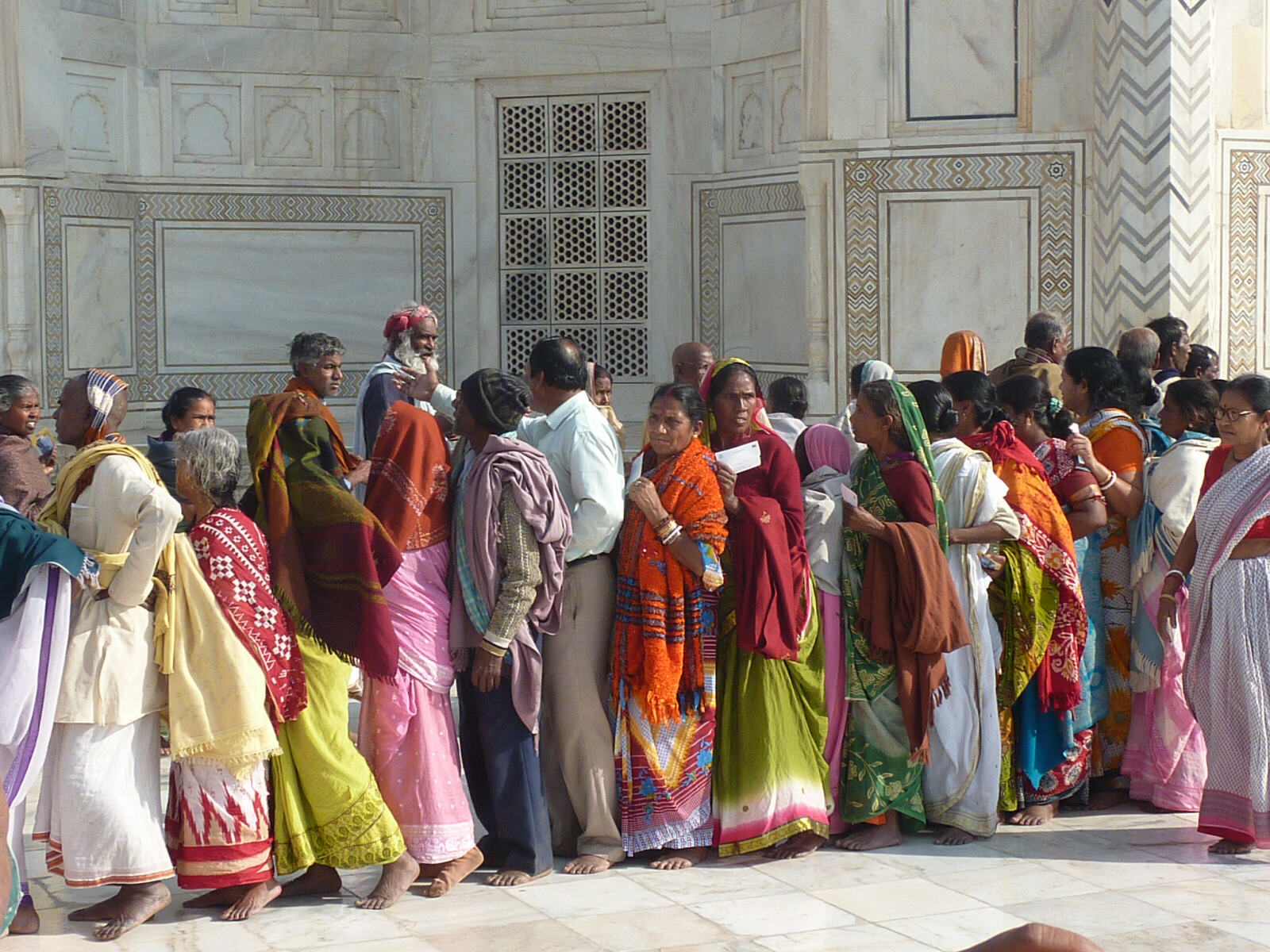
|
Once inside the mausoleum the crush reached panic level as everyone pushed forward to get a glimpse of Shah Jehan and Mumtaz’s tombs, all snapping photos on their mobile phones in defiance of the strict ‘no photos inside the mausoleum’ policy. By the time we got outside the queue had grown to (I calculated) over 800 metres long, snaking back and forwards round the raised platform on which the Taj stands, and we stood fascinated for some time watching all the attempts at queue-jumping, the angry reactions of the people who were being usurped, the ineffectual attempts of the soldiers to control them and the sheer bewilderment on the faces of the westerners caught up in it all – wonderful entertainment. Close-up the huge crush of humanity seemed overwhelming yet as we walked back down the gardens the enormous Taj Mahal came back into perspective and the masses of people looked no bigger than ants. |
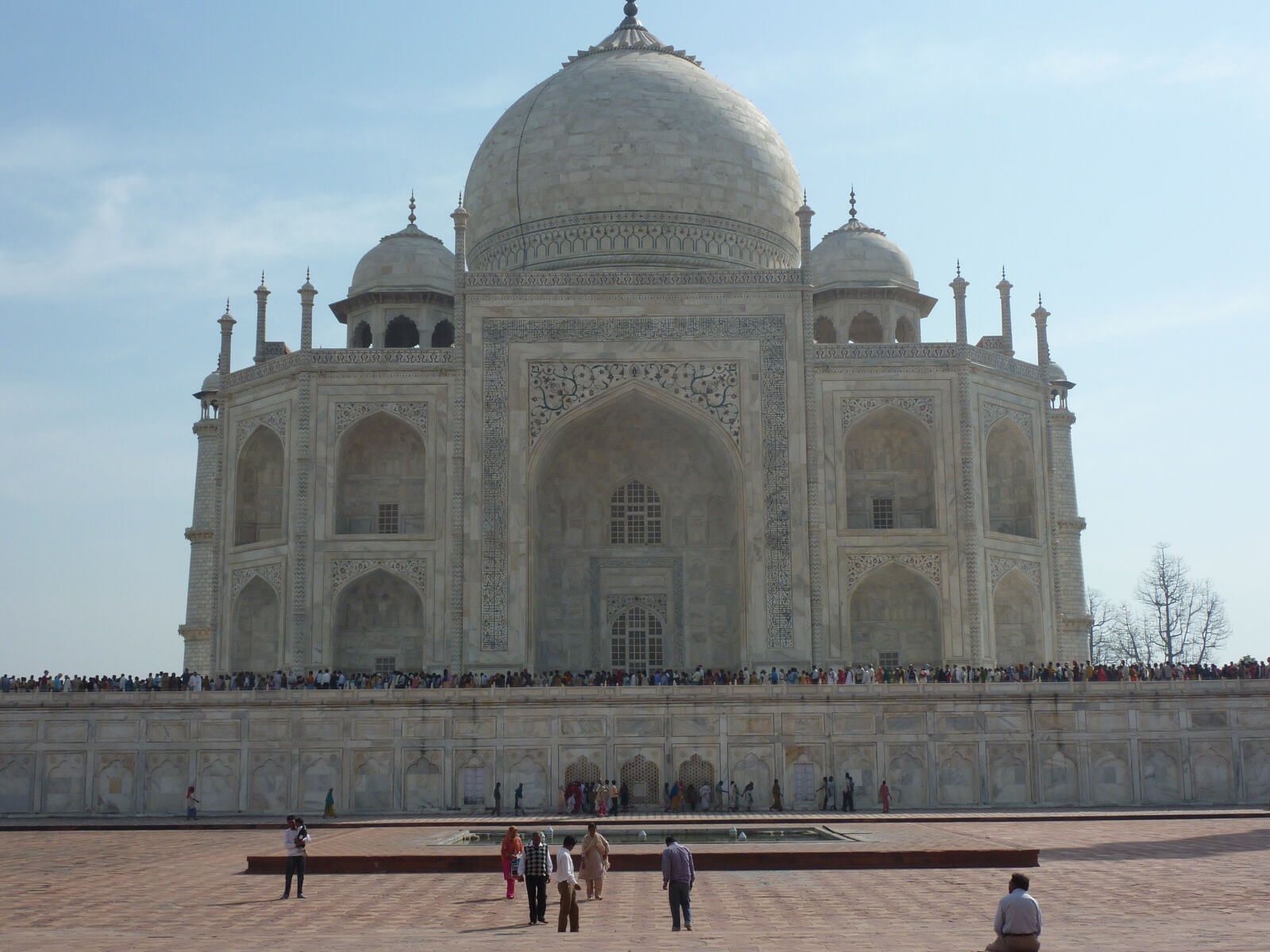
|
The Taj Plaza hotel is full tonight so we moved yet again to the Tara Palace, a newly-built hotel a little further down the road which was so new that it was very clean, but rather unfinished. Our large room (Rs 1,850) had several bunches of wires sticking out of the wall where electrical equipment was still to be installed. At dusk we treated ourselves to hugely expensive drinks in the bar at the nearby Oberoi hotel, with a music and dance show going on at the other side of the Oberoi’s pretty gardens, and a view of the Taj Mahal, obviously, at least until it got dark when the Taj disappeared because it is not lit up at night ‘for security reasons’. Our room would have been nice except the festival celebrations went on in the street outside for much of the night and it was very noisy – at 3am Sheila went out wrapped in a blanket to get them to turn the music off and they could tell by her face she meant business! |
Delhi
|
Sun 28th. Because the trains are too early or too late, or maybe because we’re getting soft, we got a car for the 200km drive to Delhi for Rs 2,300. We had been looking for hotels in Delhi on the Internet but couldn’t make up our minds which one we liked, so we asked the driver to go in search of a couple of the ones we’d noted. As we were driving round the Karol Bagh district of the city unable to find the hotels we wanted, we noticed the Swati hotel which looked nice, and they gave us a very good room (with an actual bathtub in the bathroom) for a very good rate of Rs 3,500 a night, half the published rate. While Sheila had an afternoon nap and a good long soak in the bathtub, I went for a ride on the metro to discover that it’s a really easy, useful way to get around Delhi.
Today and tomorrow are ‘Holi’, the Hindu 'Festival of Colour' where everyone throws coloured powder and water over each other, so we put on our oldest, least favourite clothes and accepted the hotel staff’s invitation to the roof where we and another European couple covered each other and the staff in coloured powder. Rather than go and wash it off straight away, we went out for a walk up and down Ajmet Khan Road, the nearby shopping street, where everyone laughed, took our photos and wished us ‘happy Holi!’, although we were refused admission to a department store where Sheila wanted to buy some nail varnish remover. Still covered in colours we went into the ‘Crossroads’ restaurant on the corner and had nice wine, beer and a delicious meal. The restaurant filled up with western tour groups with their Indian guides and they wanted to take our photos too. When we got back to the hotel we really appreciated having the bathtub to wash it all off. |
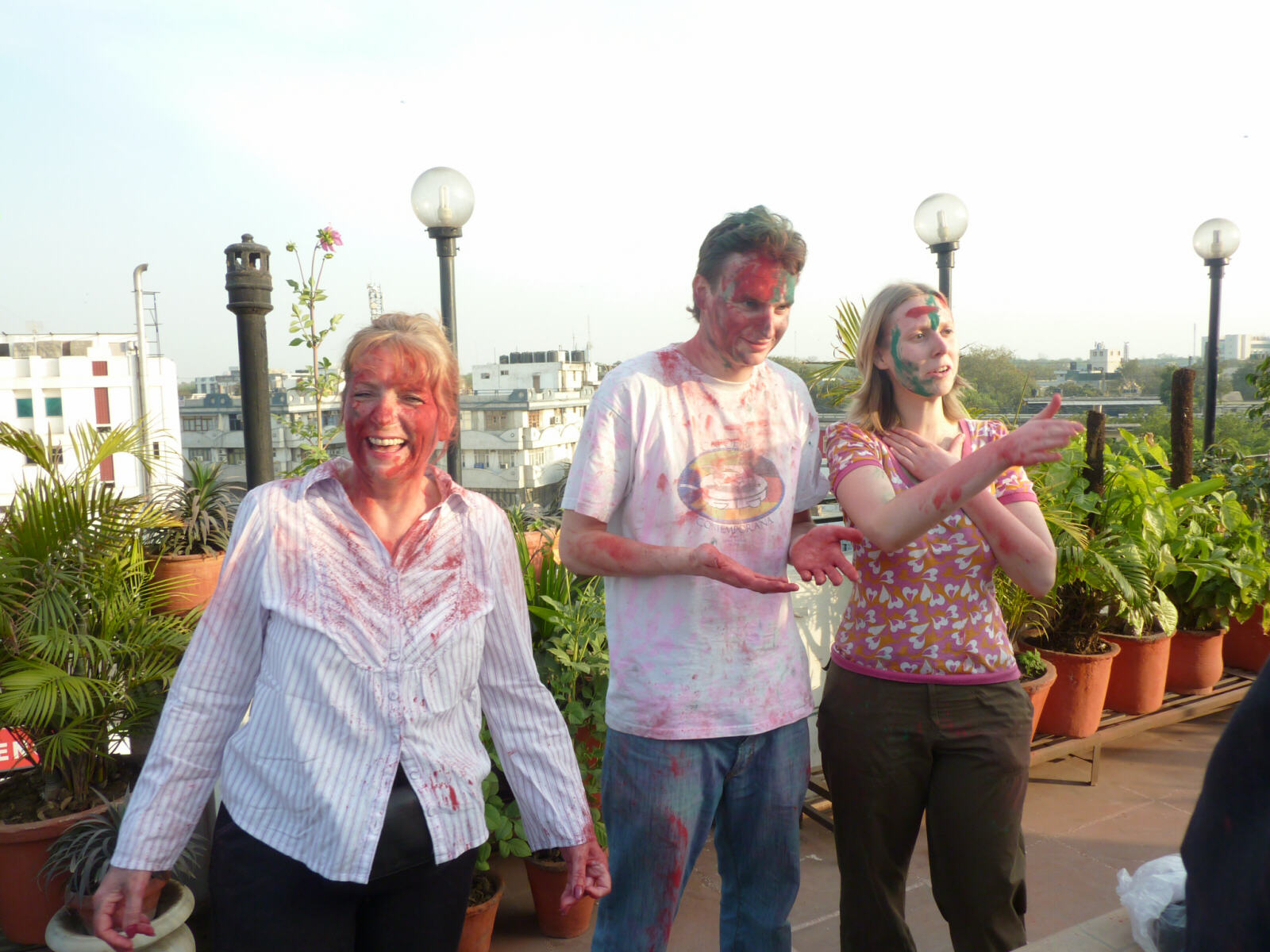
|
We also got our washing back that we had only handed in a couple of hours earlier, and this time it was done professionally.
Mon 1st March. At the Swati hotel we had the most comfortable beds in the quietest room we’ve experienced this trip, possibly in the whole of India, it was wonderful. Breakfast, included in the price, is a buffet of dhosa or paratha with veg curries and pickles in the food court next to the hotel. Today Delhi is closed for the holiday, even the metro is not running, so we had a quiet day indoors to avoid being ‘coloured’ again by exuberant celebrants, then in the evening we cautiously ventured out for a lukewarm beer on the rooftop of Amit Hotel and a nice meal at Dana Choga family restaurant, full of Indian families and their children.
Tues 2nd to Fri 5th. Sightseeing in Delhi. We got the metro into Delhi old city and walked through the bazaars to the Red Fort, another imposing Mughal fort and palace complex constructed by Shah Jehan. An artificial 'river' used to run through the rooms of the palace to keep them cool. |
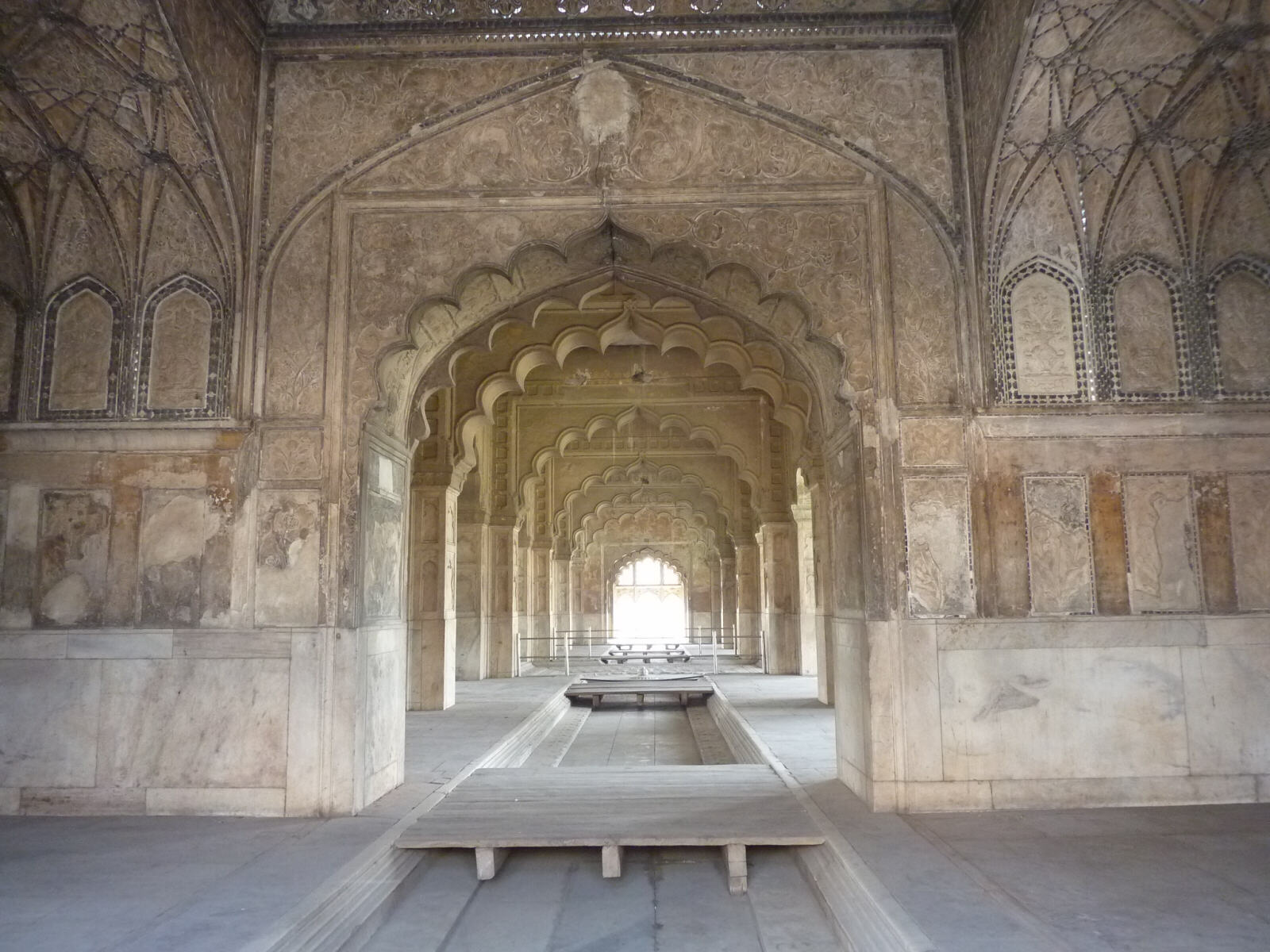
|
We then walked through more bazaars and into the run-down slummy area surrounding the great Jama Masjid, largest mosque in India, where the mosque ‘officials’ are doing their best to cheat the tourists – first they said women must have their heads covered (not true) so Sheila should buy a scarf from the shop they took us to (where they get commission), then they said there is an entrance fee of Rs 200 per person (also not true). There is a camera charge of Rs 200 and when we left the mosque they asked for the camera ticket back so they could give it to the next tourists and pocket the Rs 200 for themselves. Very irreligious people supposedly in charge of a religious place. We had a look at the famous Karim’s café down a side street near the mosque but it was full (Sheila breathed a sigh of relief because she didn’t fancy the brain curry which seemed to be their signature dish), so we walked down another bazaar and got the metro home. We also went shopping in our local bazaar in Karol Bagh or on the Paharganj bazaar, the ‘travellers street’ of Delhi, where Sheila invested in some fragrant oil and burners. In a beauty salon in Ajmet Khan Road Sheila had a really good pedicure to repair some of the damage – India is not kind to the feet!
Another day we got the metro to Central Secretariat to see Lutyens’ Governor’s residence, now the Presidental palace and the nearby government buildings. The ‘Rajpath’, the great central avenue, was so long we got an auto-rickshaw down to the India Gate at the other end. |
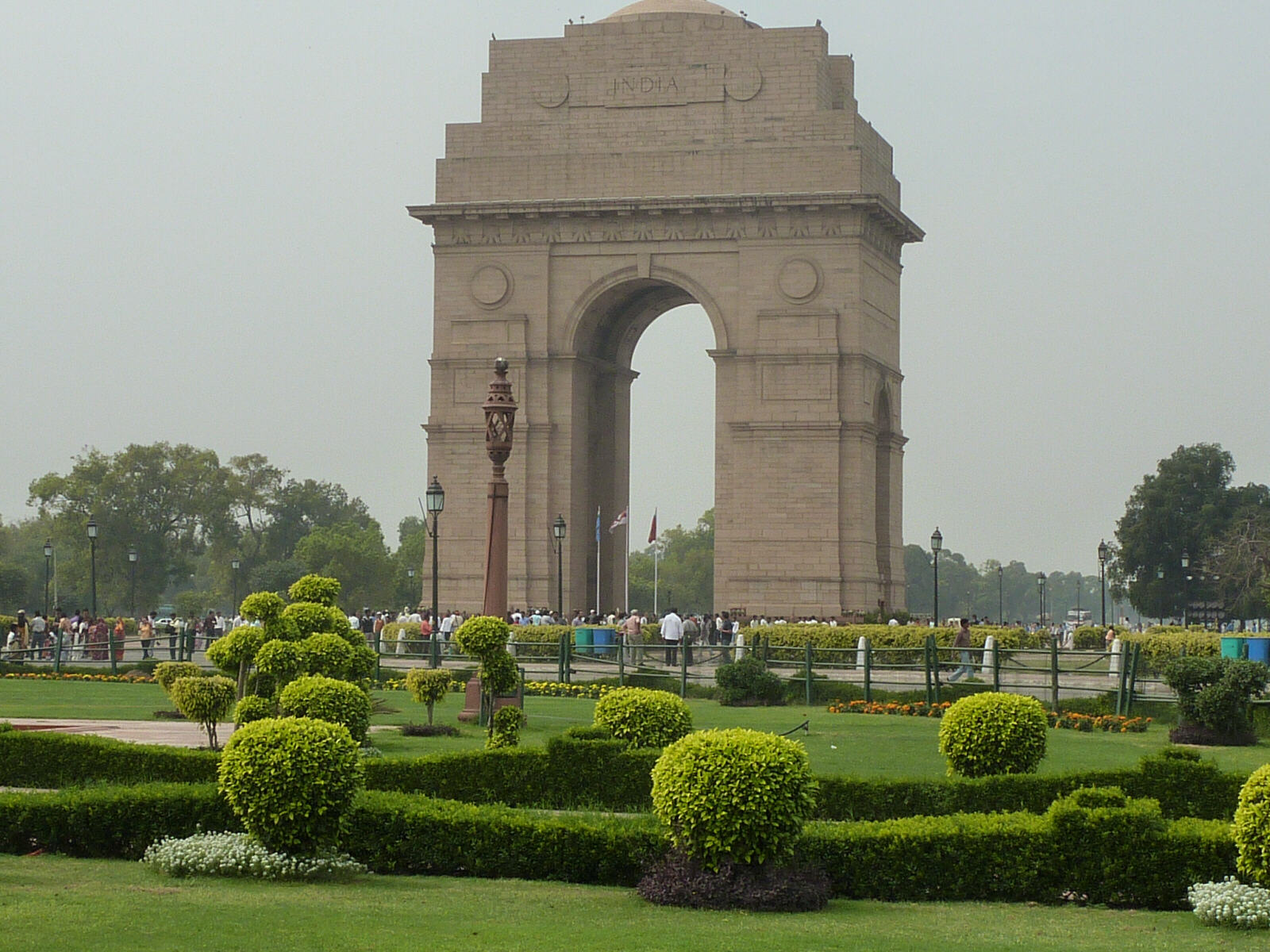
|
We tried to go to Humayun’s tomb but the taxi driver got lost and took us to Safderjang’s tomb instead, which turned out to be very pretty so we went in to see it anyway. It was one of the last great Mogul tombs in Delhi while Humayun’s was one of the first, but the essential plan is the same – a huge impressive four-square mausoleum on a raised plinth set in attractive gardens. |
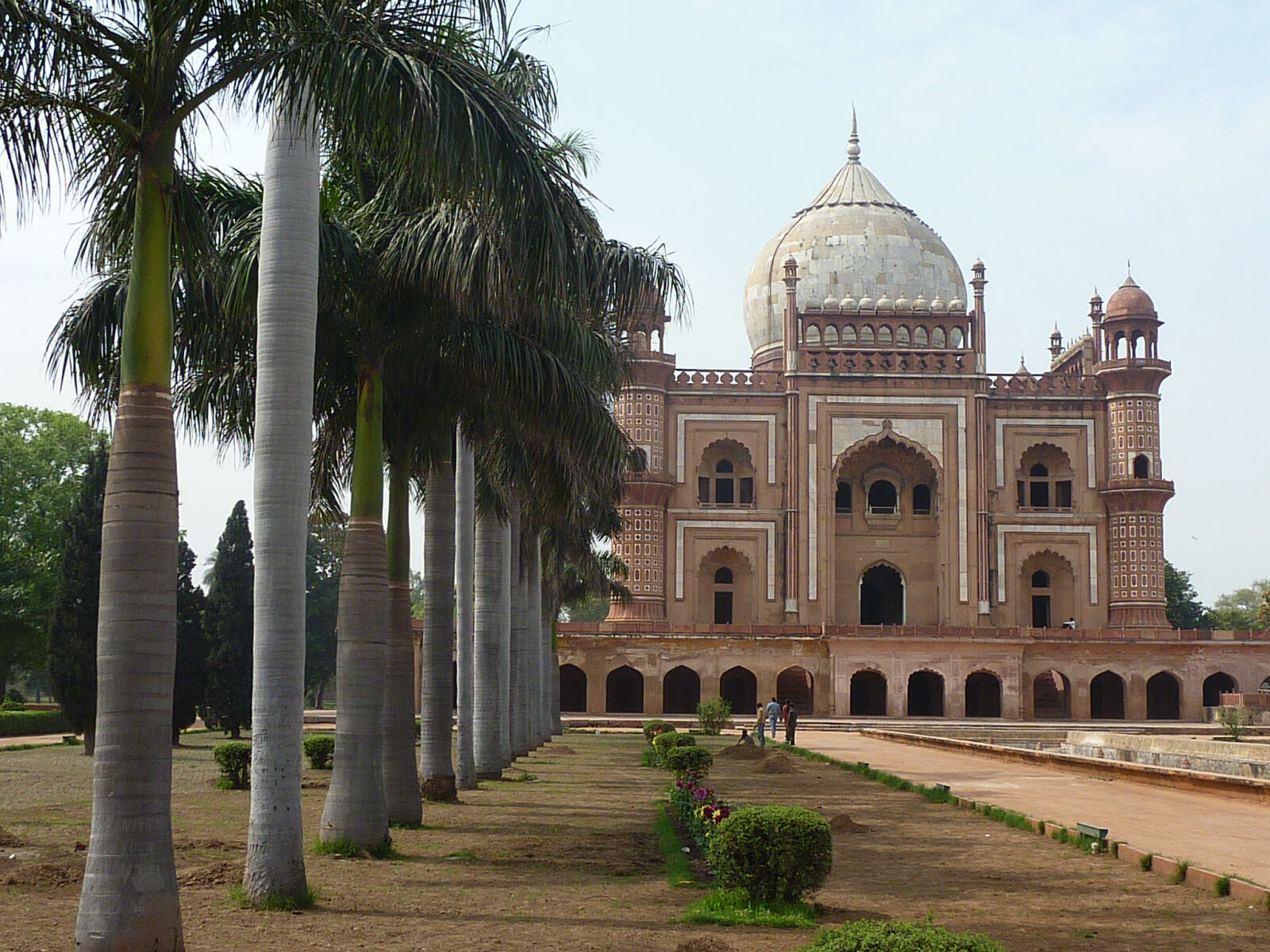
|
After the tombs we went back a further 500 years or so to Qutb Minar, a very impressive tapering victory tower in very good condition, erected in the 12th century by the rulers of the first Muslim kingdom in India. Adjacent to the tower are the remains of the first mosque in India, built at the same time, and in the courtyard is the famous iron pillar which is much older again, but has never rusted. Apparently it would have been impossible for them to make a pillar with such pure iron using the technology that existed at the time, but there it is! |
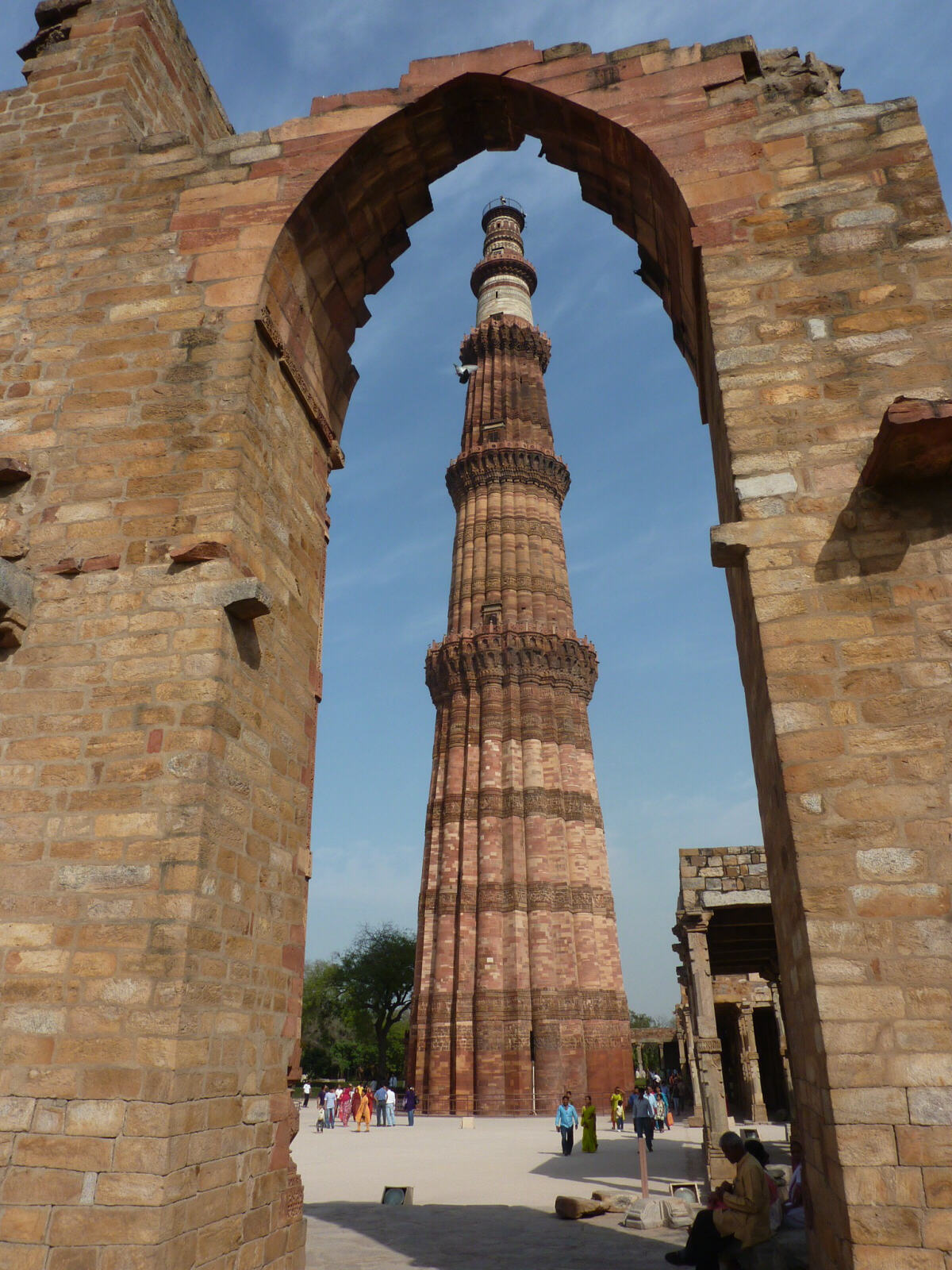
|
After tramping round all these monuments in the heat of the day we needed refreshment so we went to the old colonial Imperial Hotel and had ‘high tea’ – tea with sandwiches, scones with jam and cream and cakes - and fresh orange juice and lemon tart all for 10 pounds, sitting in their cool café courtyard. |
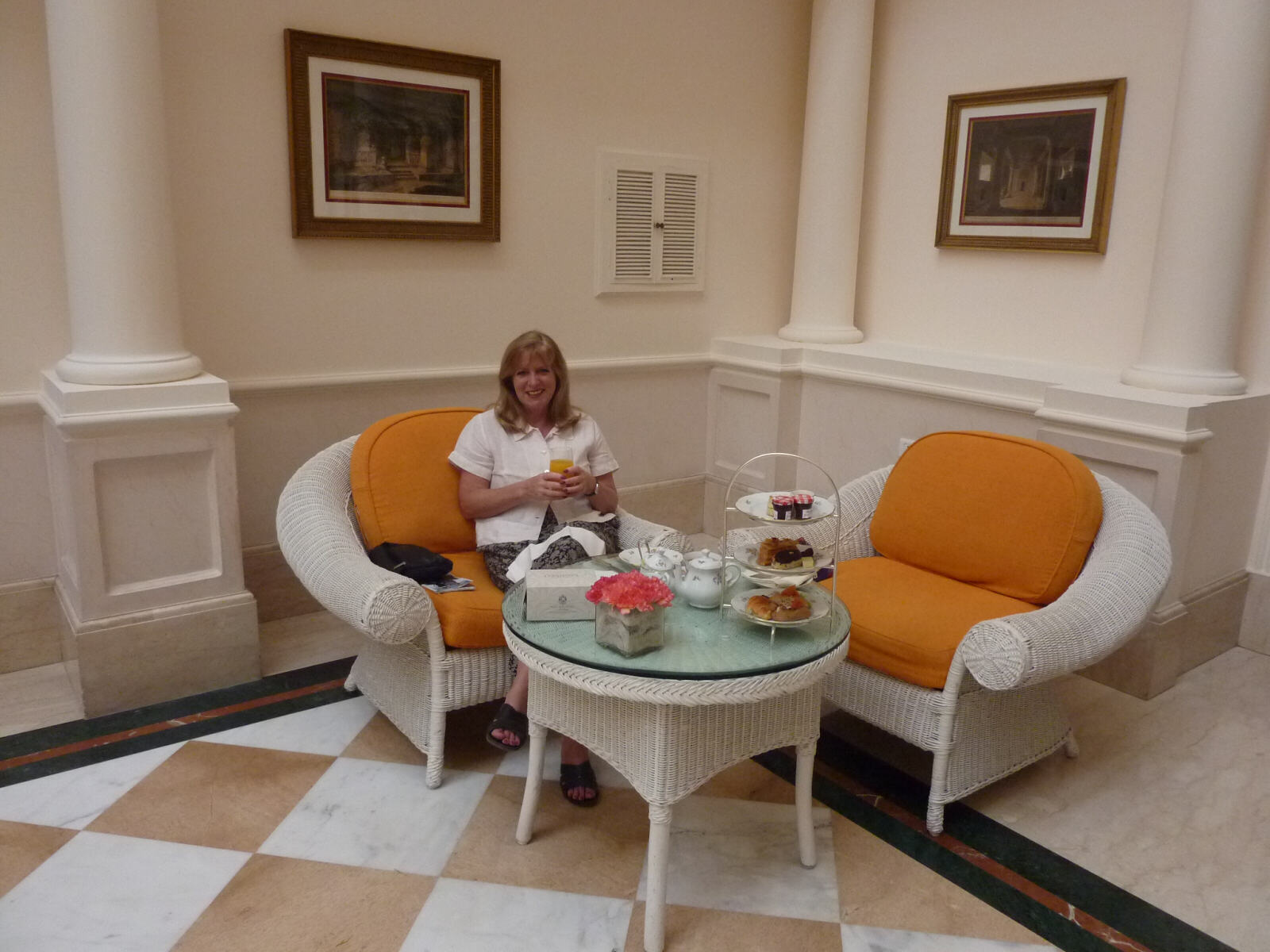
|
A little way down the road we had noticed a seafood restaurant so we went to have a look and they brought out huge live lobsters and crabs for us to inspect, but we decided against it. Another day we went to the other ‘old colonial’ hotel, Maiden’s, to have a pot of tea in cool, Raj-style ambience, surrounded by a wedding party of Americans dressed in full Maharaja’s outfits with elaborate, colourful turbans. Back up the road we went to Connaught Place, ‘the heart of New Delhi’, another Raj-era Lutyens masterpiece with a circular central park surrounded by colonnaded buildings with shops and restaurants. It must originally have been very grand and elegant but now the effect is rather hidden behind the street vendors and road works. To get away from a tout who was following us we went into the United Coffee House on one of the arcades facing the park, a very popular 1940s style restaurant and bar with high ceilings, chandeliers and walls covered with coloured inlay. We had beer and peanuts there and we were still full from high tea so that was our ‘dinner’. On other days we went back to Crossroads restaurant again and had more excellent curries washed down with nice Indian wine. In the early hours of Saturday morning we flew home.
And finally, anti-roll bars, Indian style! |
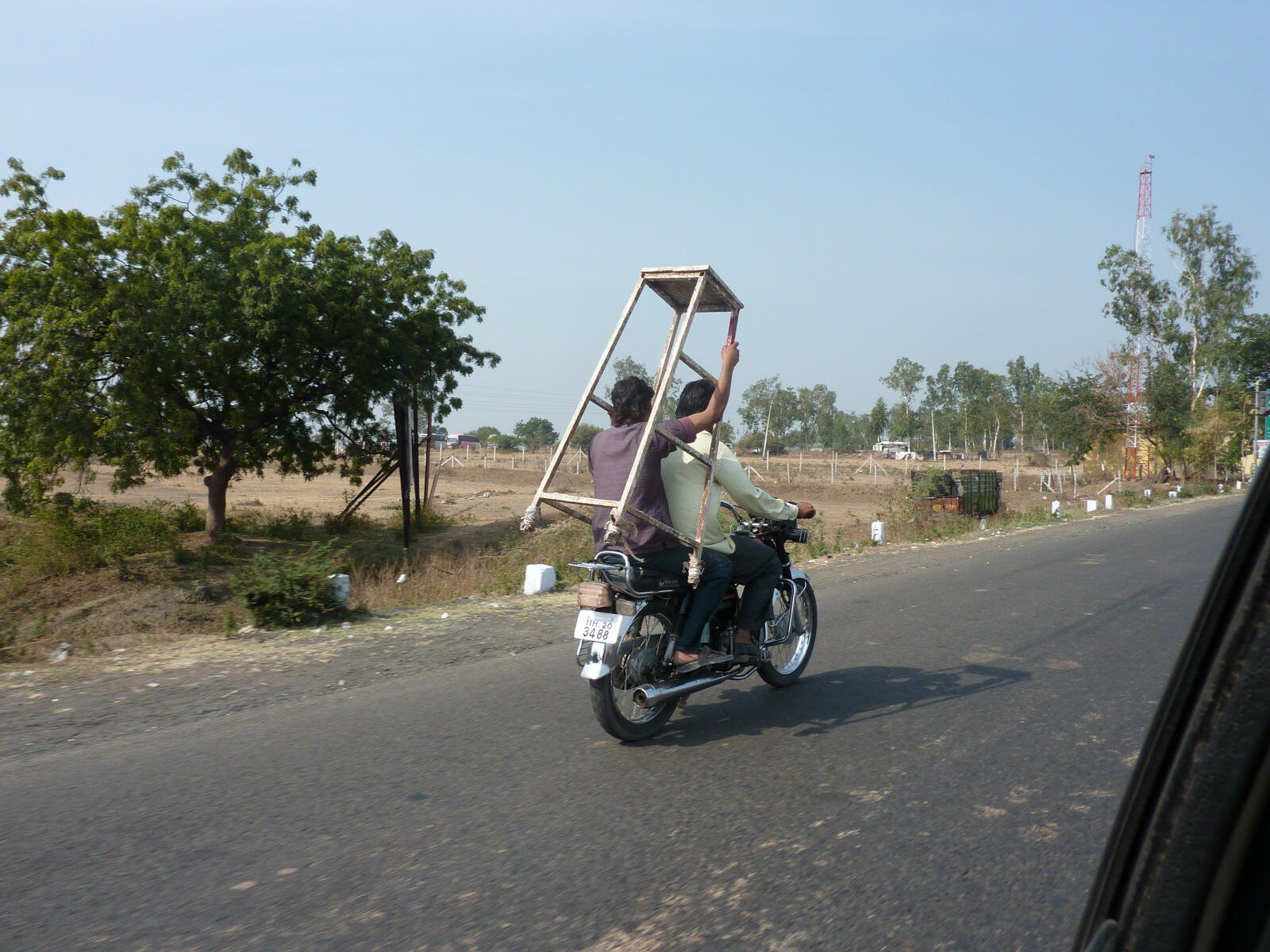
|
An Indian quote: In India, fresh air and small change are hard to find!
Sheila’s quote (while being hassled by priests in a temple): We came for praying, not for paying! |
If you would like to see more of our travels just click the map.
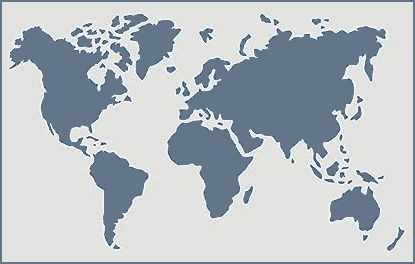
|